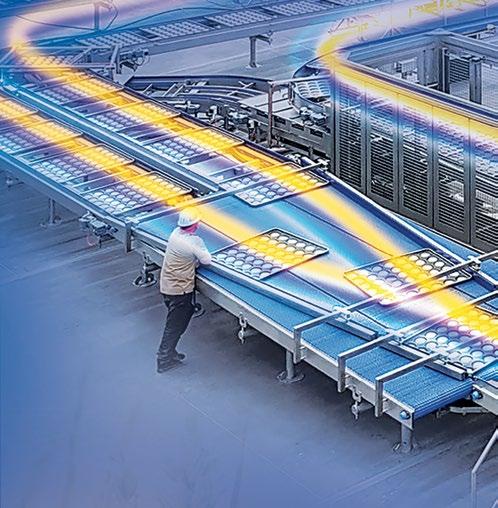




























































































 Catalina Mihu, Editor-in-chief
Catalina Mihu, Editor-in-chief
Your
commments or suggestions are always appreciated: e-mail: mihu@foodmultimedia.deMay was the 12th month in a row of record-breaking temperatures, worldwide. The Copernicus Climate Change Service (C3S), funded by the European Commission, observed that we’ve just had the warmest May on record, this year. Science-based projections estimate there is a 61% chance that 2024 will break last year’s record as the warmest ever recorded, going as far back as 1850 (source: NOAA). As much as we’re eagerly ready to enjoy our summertime, this is the grain of salt of our reality this year, and every year from now. ‘Talking about the weather’ is departing from the small talk list of topics it ruled over and is now a loaded topic.
It wasn’t by coincidence that the first topic of conversation at the AIBI Congress, held in May, was sustainability. All facets encompassing sustainability were open for discussion, and what each means for the entire supply chain. Moving forward, making connections in a fragmented market is the challenge. It was one of the conclusions of the insightful conversations we were a part of, at the association’s gathering in Hamburg. Turn the pages for more details about the event and the perspectives shared!
Regulations determining actions on sustainability efforts and goals were among the aspects under discussion. As with most things, the engine of implementing changes runs on money. It is always implied, but it can sometimes go unmentioned. Coincidentally, on the very same day the baking industry was discussing sustainability, energy, climate, automation and the workforce – all interconnected topics – Reuters published a special report that shed a new light to this elephant in any room where sustainability is assessed and investigated. The news agency ran a large-scale data analysis and found that a program meant to help developing nations fight climate change is funneling money back to rich countries, in the billions of dollars. They have been sending funds for ‘support’ with climate-related woes to parts of the world in need over the past years, and did so with interest rates or other strings attached that benefited the lending nations. For example, Ecuador sought funding to fight the effects of climate change, of which, a recent one was the 2023 flood, but it received “more loans than grants”, Reuters’ investigation showed. The fact that the world’s cocoa supply is growing more unstable by the season, with Ecuador being the fourth biggest producer worldwide, is a direct consequence. The effects are already being felt in the baking world too – even if we do choose to look away from the humanitarian crisis; after all, the Earth will go on fine without humans for about 8 billion years still.
But, back to banking on humans (since it’s the only choice with humans in it), I am hopeful to see changes in progress, starting with the hardest one of all – the change of mind. There is hope that things will turn around yet, and there are signs that they are in motion, and sustainability will be the way to do it. Sustainability targets are down to all of us!
For now, it’s not all doom and gloom. I hope that everyone enjoys summer, every day of it!
Catalina Mihu
The 38th AIBI Congress brought the baking industry together this year for the moment’s most important topics, decision-making meetings and long-awaited reunions. The International Association of Plant Bakers organized this year’s event with the theme ‘21st Century Breeze over the Bakery’, and a picturesque location to match it: the city of Hamburg.
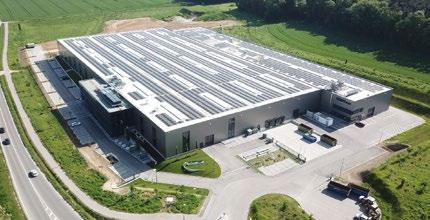
True to its motto, ‘Standing still is a step backward’, Kempf successfully completed its ambitious relocation project in little over a year. The new pin at Reutfeld 1, in Rohrbach, has officially been dropped on its brand new headquarters, reminiscent of a New York atmosphere.

ENERGY CONSUMPTION MONITORING IN BAKERIES
Engaging in energy consumption monitoring offers invaluable insights into energy usage patterns, trends, and opportunities for improvement.

importantly, dough separating: the quality of several product ranges relies on perfect, consistent laminating and sheeting. Achieving the desired number of layers in the exact thickness desired, for the optimum characteristics of each end product, can be a matter of only setting up the right production line correctly.
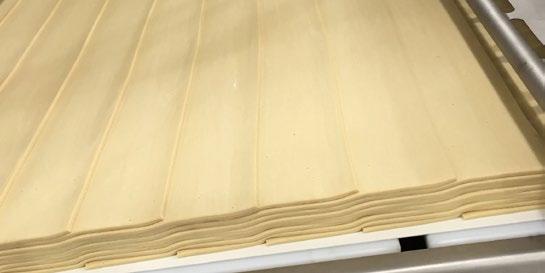
An entire fleet of iconic crackers built its consumer base on their open, flaky texture, which is produced by layering the dough. Reading Bakery Systems designed a new, 90-degree technology concept for the laminators manufacturing this dough.

From the beloved classics to the unexpected modern creations, the finest viennoiserie and puff pastries enjoy unwavering commitment from consumers. Along with the enthusiasm around all things patisserie, expectations are also rising.
06 AIBI 2024 Congress: 21st century breeze over the bakery
14 Kempf: A new HQ with a NY state of mind
AND SHEETING
20 AMF Bakery Systems: Watch this space (between dough layers)!
26 Reading Bakery Systems: New laminating technology design, at the right angle DIVIDING AND ROUNDING
24 Koenig: Accurately divide and conquer!
TURNKEY LINES
28 Rademaker: Men at work, on automated lines
30 New Era Machines: Mission code name: soft dough biscuits
32 MECATHERM : The French flair 36 Delifrance: Seven rising trends in 2024
38 Sustainable efficiency: Intelligent energy consumption monitoring in bakeries
42 Fedima: Emphasis on enzyme safety
48 Fondants: Flow and crystallization behavior
56 FMCG Gurus: The right breakfast to start the day

Food2Multimedia is a publishing house operating at an international level and specializing in researching and editing technical information for the baking sector.


baking+biscuit international
Our specialist journal concentrating on production professionals in large companies in the industrial and chain-store sectors. Published six times a year in the English language.
Our Review series provides in-depth analysis of clearly defined issues. This involves market analyses and is a comprehensive, informative presentation of the state of the art in process engineering.
The f2m dictionary translates bakery terms into a mulitude of different languages.

The 38th AIBI Congress brought the baking industry together this year for the moment’s most important topics, decision-making meetings and long-awaited reunions. The International Association of Plant Bakers organized this year’s event with the theme ‘21st Century Breeze over the Bakery’, and a picturesque location to match it: the city of Hamburg.
+For three days, the Grand Elysee Hotel in Hamburg became the capital of the baking industry, hosting the event organized by the International Association of Plant Bakers (AIBI). The fixed points in the agenda included the association’s General Assembly, a full day and a half day of presentations, panels and information exchanges, and networking time, from May 22 to 24.
As one of the last formal tasks of his two-year tenure at the helm of the association, Georg Heberer introduced the new AIBI president, elected at the General Assembly: Jean-Manuel Lévêque returns to the leadershipof the industry association, after his first mandate from 2015 to 2017. He is chairman and co-owner of Novepan, a medium-sized company specializing in the premium bake-off industry with six factories in France. In his previous role within AIBI, he was a Vice President and also represents the French Federation of Industrial Bakers (FEB), as its Treasurer. A respected name in the industry, Lévêque spent the bigger part of his career within the Grands Moulins de Paris/ Delifrance Group, including the role of Delifrance CEO, which he held for 15 years. The announcement was made in a festive environment, during the gala dinner organized at the Rickmer Rickmers, Hamburg’s landmark museum ship and restaurant. The new Vice Presidents were also announced – Guido Vanherpe and Kari Meltovaara. In his introductory speech, the new president outlined the organization’s biggest priorities for the following weeks and beyond, which include “sustainability and the reputation of

our industry, which will be the most compelling argument that will enable us to attract new talents.”
As he later noted as he moderated the ‘International developments’ session, held on the last day of the Congress, the industry is, at the moment, navigating intense transformations, which include high-profile mergers and acquisitions, while also undergoing radical changes in response to sustainability priorities, raising the bar on digitalization, and the availability of raw materials and energy.











AIBI’s newest members were introduced to the Congress attendees, a sign of the organization's ambition to grow its ranks and reflect not just a resilient industry, but a thriving one: associations from Slovakia (Slovenský zväz pekárov, cukrarov a cestovinárov SR – SZPAC) Poland (Polish Bakers Association – Stowarzyszenie Producentów Pieczywa –SPP) and Ukraine (Ukrainian Bakers Association – UBA). Representatives from Ukraine were, regrettably, unable to join the event. The new expansion brings the number of AIBI member associations up to 16, plus three associated members: BakeHellas (Greece), Rabobank (the Netherlands), and Coop Genossenschaft (Switzerland).
Class
The suite of insights and panel discussions at the AIBI Congress is traditionally highly anticipated. This year, the moment’s hot topics ranged from sustainability and regulatory updates to labor force issues and advances in AI.
Ample spotlight space was given to sustainability and energy, in a session moderated by a traditional partner of AIBI events – Cyrille Filott, Global Strategist, Consumer Foods, at Rabobank (and sponsored by Puratos). The brainstorming endeavor set out to find how to move the sustainability agenda forward as the industry is facing tensions related to raw materials and energy, while aiming to meet rising consumer expectations at the same time. Perspectives on energy management were analyzed, with topics focusing on EU Sustainability Agreements, the wheat carbon footprint, and navigating a greener future.
It’s not all bleak news, as Pierre Tossut, Puratos CEO, underlined in his address: “Bread is already very low in the rank of carbon footprint per kg of product, among foodstuffs.” It accounts for 1.6 kg, while 1 kg of fruit equates to 0.4 kg CO 2 emissions, as expected for a natural product. For further reference, coffee accounts for 28.5 kg and beef is at the top with the highest carbon footprint, with a staggering
“AIBI’s biggest priorities for the following weeks and beyond will include sustainability and the reputation of our industry, which will enable us to attract new talents.”
Jean-Manuel Lévêque, President, AIBI
99.5 kg, according to the data he provided. Moreover, “85-95% of a bakery’s emissions are not coming from the factory, but upstream,” added Fillot.
EU sustainability agreements were analyzed during this session, as they shape all strategies formed in Europe. Article 210a is of particular relevance in this regard, on agriculture sustainability, with guidelines published in December 2023. “Cooperation between different levels of the supply chain is key to the industry’s resilience,” the EU Commission representative concluded.
The session’s panel discussion welcomed to the stage Guido Vanherpe – CEO, La Lorraine Bakery Group, Pierre Tossut, Michael Gutting - Managing Director, Bindewald and Gutting Group, Maria Paz de la Cuesta de loz Mozos – Policy Officer, EU Commission, and Els Bedert – Product Policy and Sustainability Director, EuroCommerce.
In its own dedicated session, workforce and digitalization issues were disseminated, with highlights including AI and automation. Established principles were combined with practical experience knowledge, in the session moderated by AIBI Board member Kari Meltovaara, Managing Director, Leipomo Rosten Oy. Digitalization goes a long way not just to make processing more efficient, but also to make the sector more attractive to a new generation of people who would want to build a career in it. The conversation in this field is very much open. “We need to explore all the digital benefits at our disposal, because we don’t make use of all opportunities at the moment, currently,” observed






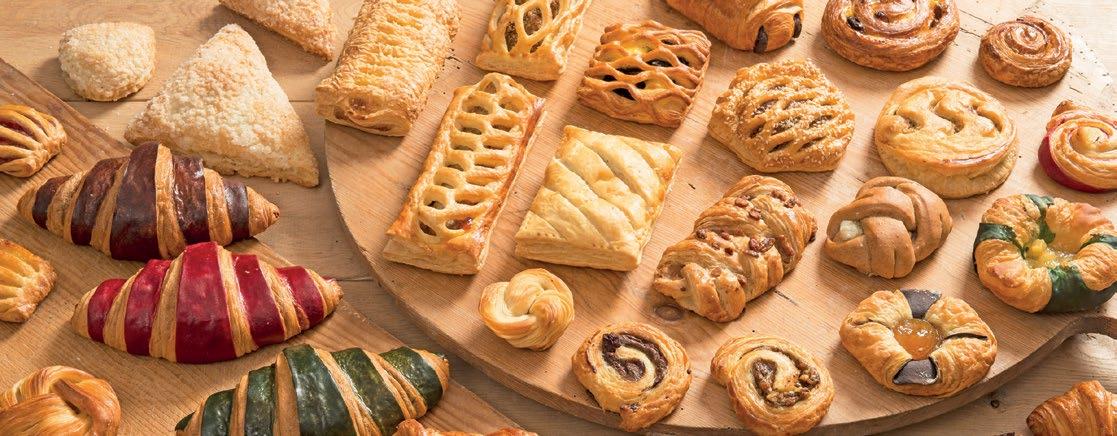

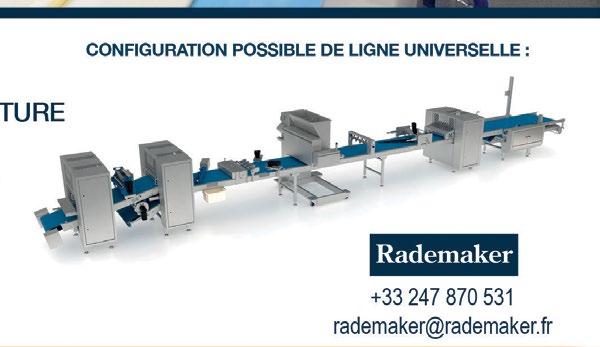

Raymond Nogael, the newly-appointed President of MECATHERM , the company that sponsored the session.
A very relevant approach to attracting people to join and stay in the industry is finding meaning in work. “Hire for attitude, train for skill,” was a key takeway proposed by Pia-Maria Thorén, from Agile People consultancy. A practical, real-life example of the importance of hiring and training the right people for the right task, and how it can help a company grow, while also upgrading for more automation, came from George Mavromaras, BakeHellas. A key question to consider is how to select new management, aside from making a straightforward, compelling argument on what production improvements will translate into for the staff, training included.
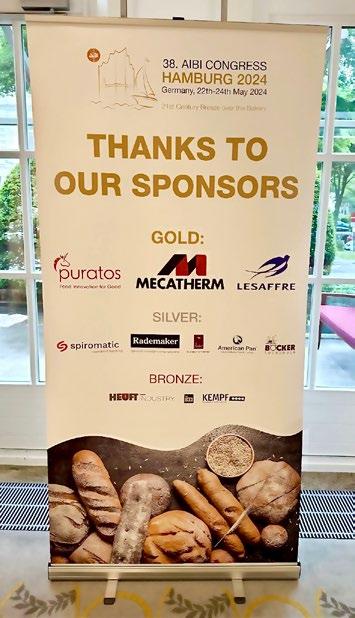
Industry leaders who joined this session’s panel discussion included Frank Kleiner – CEO, Harry Brot, Sebastian Gooding – CEO, Ditsch/ Valora Group Management, and Peter van den Berg –CEO, Pandriks Group.
The session on international developments, moderated by Jean-Manuel Lévêque and sponsored by Lesaffre, included interesting insights from Irene Mínguez Pablos –Global R&D Director, Grupo Bimbo (representing the Latin American perspective), Lévêque (EU’s point of view), and Eric Dell – President and CEO, American Bakers Association. Remote interventions also came from
“Bread can drive a wedge between us, Europeans, too. If you don’t consider geopolitics, geopolitics will consider you, and for companies, that is bad news.”
Peter Eitel, Senior Manager, PricewaterhouseCoopers Germany
Taipei, South Africa and Australia, offering a picture of unique markets and issues that each is confronted with. It reflected AIBI’s objective to establish closer connections with new bakery organizations and even more manufacturers.
On the topic of international developments, bread has always been an early warning indicator of geopolitical crises: the French Revolution and the Arab Spring, for example, and now the war in Ukraine, argued Peter Eitel, Senior Manager, PWC Germany. He analyzed what it means to bake in a fragmented world, which is becoming even more deeply fragmented as a result of overlapping crises. “Bread can drive a wedge between us, Europeans, too. If you don’t consider geopolitics, geopolitics will consider you, and for companies, that is bad news,” he warned. The researcher’s recommendation is to find a balance and have a futureoriented yet proactive approach to business. Upcoming events to watch, and calculate for because of their worldwide impact, include the US elections and the dynamics between Russia, China and the US, the expert anticipates, as Russia is bound to become a more important food producer, due to climate change. The assessment is especially relevant in light of overlapping this list of countries with that of the world’s biggest wheat producers, which are, in order: China, India, Russia and the US.
This concentrated agenda of sessions offered, nothing short of an advanced University syllabus, was a necessary, veritable boot camp in baking business inspiration, entirely justifying the high expectations built around it.
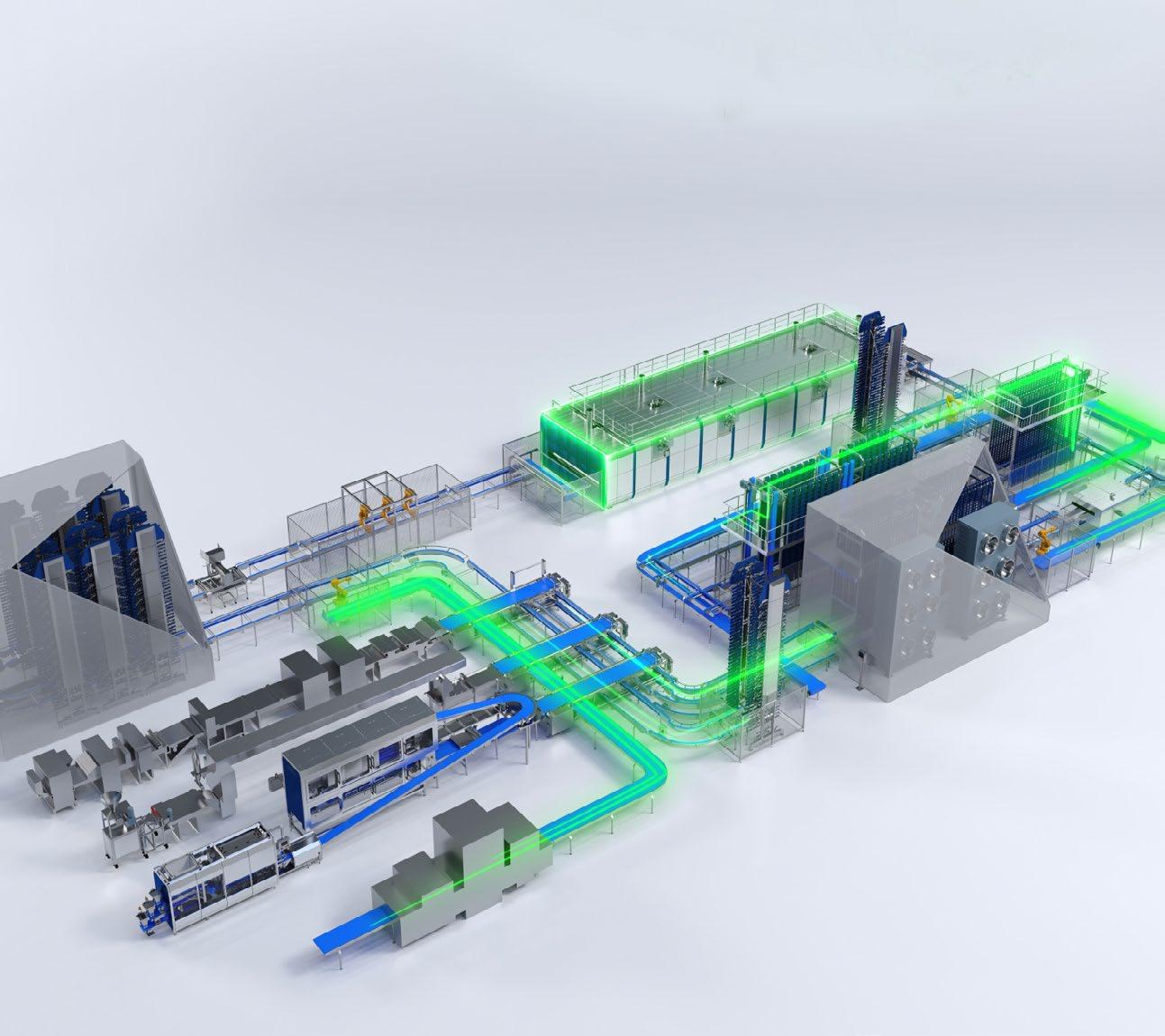
Product quality, industrial performance, and sustainability. At MECATHERM, we aim to support you everyday as you explore new ideas to stay ahead, and overcome challenges while reducing your carbon footprint. We are developing numerous innovative and sustainable solutions to optimize your energy efficiency throughout your entire production line. Let’s discuss and discover the array of options awaiting you.
For the first time, a market tour was also organized, a new, hands-on opportunity to catch – and taste – a glimpse of Hamburg’s bustling baking scene and the city itself. Pierre Nierhaus served as the guide of the tour, a trend expert for the hospitality industry who regularly observes and travels to the most inspiring metropolises worldwide. Several different kinds of businesses were selected to be a part of the tour, for a hands-on experience of different trend interpretations. The first stop highlighted Hamburg’s retail: one of Edeka’s supermarkets, headquartered in Hamburg. It offers many product choices in the bakery aisle and the in-store baking area, including an interesting array of premium and better-for-you bread products, fresh and packaged.
Mutterland with its unique retail concept was also on the itinerary. The fine food retailer has a restaurant, bakery, chocolate shop and a supporting online shop. It sells around 5,000 delicacies from 200 German manufacturers. Its Hamburg headquarters won the ‘Store of the Year’ award from the German Retail Association, in 2022. Next door is a well-known bakery in Hamburg, Junge Die Bäckerei, which was also chosen to represent the city’s baking scene in the tour. This family business, now in its fourth generation, has a network of over 200 shops and bakery cafés in the north of Germany. The business is the proud recipient of several awards acknowledging its products and employees. The Copenhagen Coffee Lab was another highlight, with its Danish products. It is found in the Rindermarkthalle St. Pauli marketplace, alongside around 30 other small, local shops.


To end the tour on a very high note, Hotel Tortue was the last stop, with a visit to its themed restaurants: from the rooftop space reminiscent of a beach bar (plus an urban skyline and a view of the new Hamburg State Opera building, a city landmark), to the beautifully decorated Asian restaurant Jin Gui, and Chez l’Ami – another dining space with Francophile culinary accents. The complex, presented by the owner, Marc Ciunis, also features several bars and a working space always decorated with carefully crafted arrangements of fresh flowers. The interest in the tour with limited seats available was clear, with a waiting list to prove it. Lutz Birke, Head of the Department of Economics and Innovation, City of Hamburg, offered in the opening speech of the Congress a quaint picture of the industry, as it could be observed during the tour, too: “In every loaf of bread, we taste tradition and innovation. The German bread market is a picture of vibrant diversity.”
As customary, the next edition of the AIBI Congress will be held in two years, in its President’s home country – France. The time and place: to be announced! +++
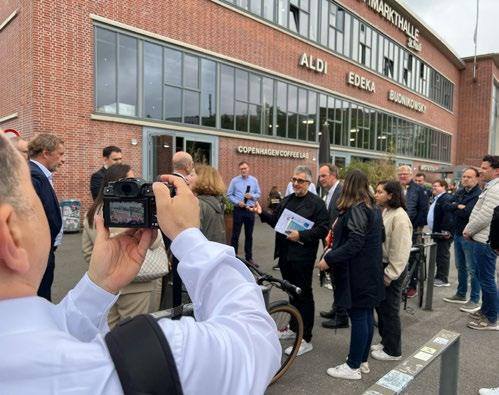
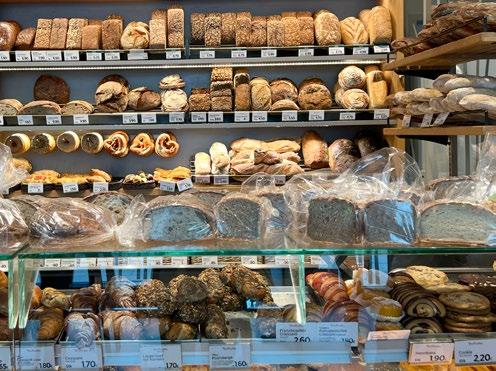

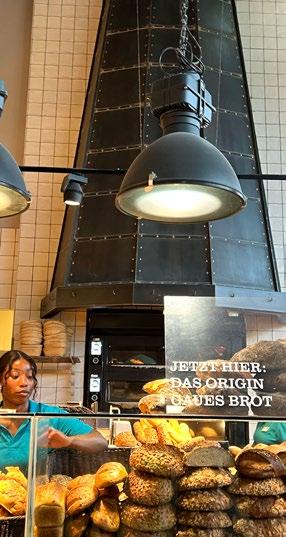
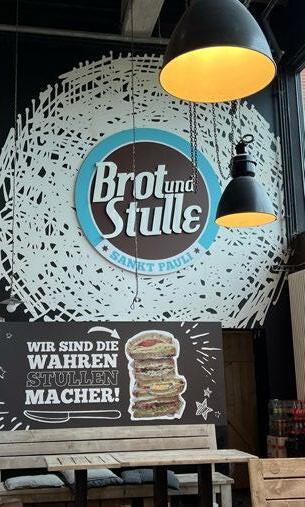




True to its motto, ‘Standing still is a step backward’, Kempf successfully completed its ambitious relocation project in little over a year. The new pin at Reutfeld 1, in Rohrbach, has officially been dropped on its brand new headquarters, reminiscent of a New York atmosphere. Not one to stand still, the bakeware specialist’s team brought German efficiency into the scene and is already at work in a new and improved home.
 By Catalina Mihu
By Catalina Mihu
+ November 2022: Seven shovels breaking ground on a crisp morning marked the first visible sign of a long-thought-out expansion project. All things considered, including an unstable geo-political environment in Europe and beyond, supply chain disruptions and global inflation worries, Kempf made the timing work and built a 20,000 sqm headquarters containing the necessary expansion of its production facilities, with space dedicated to logistics and modern office spaces. One year and around EUR 30 million later, what started as an ambitious blueprint became a fully functional building for Kempf’s 140 employees currently working at the Rohrbach facility (and counting, with hirings underway, there should be 160 by the end of the year).
The factory gradually moved, line by line, over four months, before the end of 2023. Throughout this time, production never completely stopped. Desks, computers, favorite cups and all office logistics were transferred last, in the days between Christmas and the New Year. In early May 2024, baking+biscuit International was invited for a factory tour, this being one of the first visits Kempf received at the new address, prior to the official opening event, which will be staged after the summer. As the very last details were finalized, production was already 100% operational in May.
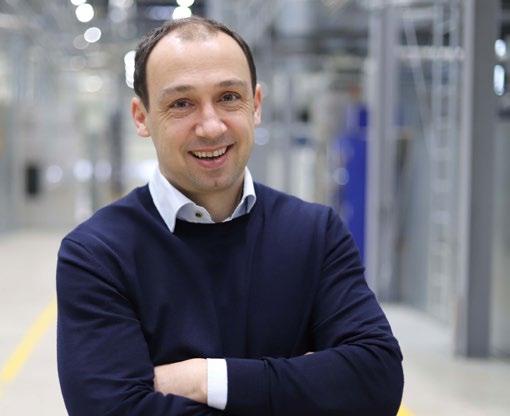
“Our goal is that we provide, in the end, PFAS-free coatings that have even better performance – better non-stick effect, easier to clean, and longer lifetime – compared to today’s fluoropolymer solutions.”
Guido Kempf, CEO, Kempf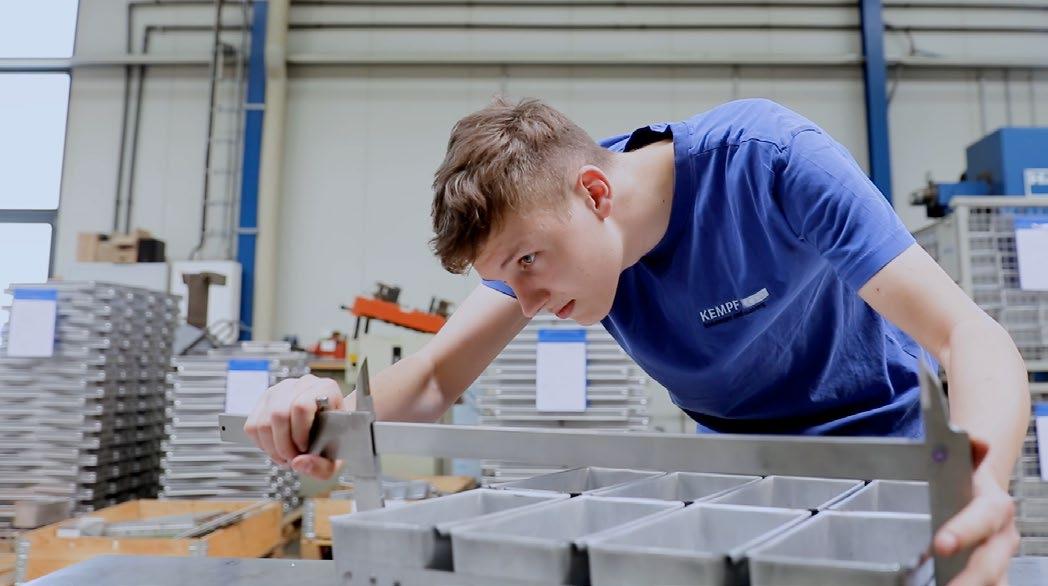
The goal was to automate the production floor wherever possible and to bring onboard new technologies to increase efficiency and productivity. The move was required, on one condition: the business had to stay in Rohrbach, the small town where it started, some 50 km north of Munich. An opportunity came about for Kempf to buy the necessary land from local farmers, and the rest is history!
The new coating plant was the first facility to turn on its lights and start operating at the new address. It was the first glimpse of the development that was being prepared around it, and which f2m witnessed during our first visit, a year ago. The coating plant was designed with room for further capacity expansion right from the beginning.
Despite some unavoidable delays with construction logistics, the land around the hall designated for coatings quickly saw the rest of the building rise. Kempf is not only building, but also constantly seeking and researching new technologies it can use in its work. An important priority is sustainability, in this regard. This is why the new building’s roof is covered with over 6,000 solar panels, for instance. With the 2,100 kWp photovoltaic system, Kempf is sourcing electricity for its own production needs and for the building itself: “The floor of the entire production area has floor heating and cooling, for perfect working conditions,” Guido Kempf says, as he underlines, “Our workers are our biggest asset and as we continue to search for the best people, we want to offer the best environment.” This is why the walls of all production areas have perforated panels that help reduce the noise levels, too.
Today, the production capacity has been expanded by around 20%, compared to the old factory. However, the new production floor has, by design, free space around all existing lines, so it can still accommodate new equipment. For example, if a new perforation or a bending line is required in the future, it can be incorporated with no disruption to the processing flow. Materials, sourced directly from the plants and not via intermediaries, are delivered in coils, meaning that the trays can be produced without any scrap, as they are already the required size when they are sent to the automatic line for perforation. Because coils of different sizes are stored here, production can start within hours of placing an order. The punching unit can make up to 1,000 perforations in one motion. This translates into a perforated sheet for a standard 60 x 40 cm tray produced every 4 seconds. The parts that are punched out of the sheet are sent back to the aluminum plant, where they can be immediately melted and reused. Next, the sheet is flattened and sent to the automated bending units. Since the highest possible level of automation was a goal from the start, all standard products are made without any need for manual labor.
Production is planned over two shifts at Kempf, with a completely automated third shift being carried out with robots, overnight. The workers load the machine at 11 p.m., and it will run independently until 6 a.m. the next day, when the morning shift arrives. Standard trays for craft bakeries are usually produced on the night shift, and a stock of standard sizes is always maintained, for faster delivery times.
A section of the production area is dedicated to bakeware that needs a certain level of manual operations, such as


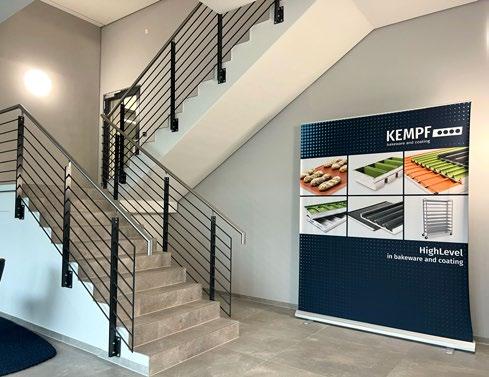

custom requests, or small quantity orders. Baguette trays go through here too: “We make them semi-automatically, although they are made in large numbers, because every bakery has its own requirements about the specifications of the convolutions,” Kempf explains. This is why they are always made to order and there are no stocks. Once the correct convolutions are made, the trays are sent for coating and then returned, to be assembled on their frames. The frames can and usually are reused, up to four times.
Kempf’s newest investment was a robotic solution that automates cutting 6 m-long tubes. Welding also uses a robot. A separate section handles peelboard production, including larger sizes, which have recently been requested more. A dedicated production line makes deep-drawn tin sets, with numerous tooling options. A similar line is operating at KeyBAKE, the Dutch company Kempf acquired last year.
The storage area is used for standard-size tray stocks, as an in-between stop for trays going to and from coating. It also has a section that works like a ‘tray hotel’, where

customers’ second set of trays can be stored long-term, on request (and for a small fee). Kempf’s main market is European, but it ships trays as far as Australia.
At Kempf, the R&D team continuously looks into product innovation, for all its product ranges: baking trays, most of which are perforated, trays with molds (e.g., for buns, croissants, and cakes), tin sets (for products such as toast bread and sandwich bread – also a big part of Kempf’s business), and trays for industrial systems – such as large baguette trays, as well as stainless steel racks. Another distinct category is customized solutions, developed to respect unique sets of requirements, such as baking branded products, and solutions to support tracking and tracing bakeware.
Among new developments, Kempf recently developed lightweight trays for Mecatherm production lines. “We have many possibilities to lower the weight; we can work together with our customer's technical teams to identify the critical
2100 lines installed worldwide and we are always around the corner.

Tasteable quality secured by over 85 subsidiaries worldwide
Ben Baker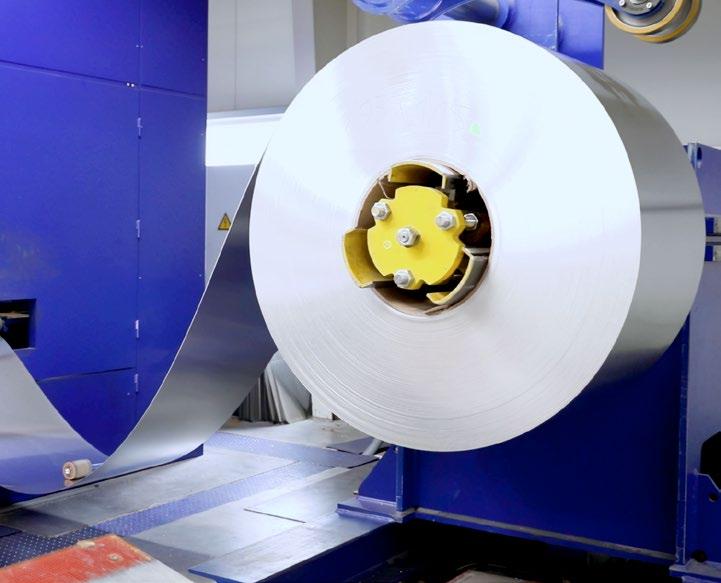
parts on the line and adjust them accordingly. In the end, every kilogram we can reduce from the tray’s weight will save a lot of energy and money per year, while it works on a 24/7 production schedule,” Kempf observes. The demand for this type of tray is growing.
The field of coatings is particularly dynamic, especially in light of the highly expected EU regulation regarding the use of PFAS, which currently holds the undisputed biggest market share. The regulation is bound to affect all industries in Europe, since PFAS are even used in clothes, for example, not just in baking, and will very likely be delayed from the tentative 2025 timeline, Kempf anticipates. But, it is a matter of ‘when’ (and ‘how’) and not a matter of ‘if’.
Silicone can already provide a possible PFAS-free alternative, and its adoption is on the rise. “For baguette lines or bake-off stations, it is still one of the best options because of its excellent baking results. Its open-pore structure has the ability to retain some of the water during the proofing process, and return it to the bread while baking. The result: uniform colorization and a crunchy crust, the perfect attributes for a baguette,” Kempf explains. By comparison, a baguette baked on Teflon will have less color and a drier crust.
In addition, the company has perfected a new solution, unique to Kemp, ahead of the ban on PFAS: plasma coating. “We’ve had very good results for all types of perforated trays, as well as bun trays,” Kempf says. Because of the application method currently used, the current limitations of this coating are deep molds – for toast, tin bread, or sandwich bread – and products high in sugar such as cakes. But, using plasma coating is very new and very much a work in progress, which is already showing very promising results. “The trays we are using on lines now are passing the 5,000 cycle mark, and on a smaller installation, this coating has already exceeded 10,000 runs and the

coating is still as good as new. Plasma has the potential to be one of the best solutions for the future,” Kempf observes. “The problem with PFAS is not the Teflon we have in the frying pans at home or the Teflon we use here, in the plant, nor the Teflon used in the bakery; it stems from chemical plants using – and mishandling – the raw materials going into it, years ago. The current concern has to do with removing the risk of a new spillover in the future. I think this is not the best approach to this problem,” Kempf believes.
The new solutions join an older PFAS-free solution, which has been on the market for over a decade: ceramic coating. This comes with pros and cons – it is very abrasion-resistant, but using it regularly for baking makes its non-stick effect wear off very fast. This makes it a non-starter for baking.
Completely removing PFAS in coatings is virtually impossible in several industries, so drafting a functioning proposal is an ongoing conversation, the specialist notes. A possible scenario for a timeline could be for a consensus to be reached by 2026, followed by an extended transition period before eliminating PFAS, Kempf anticipates. This would allow ample time for new developments that will also ‘cover’ deep, molded pans, and additional solutions altogether. However, there are always companies that are early adopters when new regulations are established, so the request for PFAS-free solutions could become a real trend in the not-so-distant future.
Kempf currently recommends that bakers test the available alternatives, while their utilization is not compulsory and production rates will not be influenced. “Our goal is that we provide, in the end, PFAS-free coatings that have even better performance – better non-stick effect, easier to clean, and longer lifetime – compared to today’s fluoropolymer solutions,” Kempf anticipates. The plasma coating is a step in this direction. Acting as a surface treatment, it comes with the benefit that it cannot be damaged, i.e.,

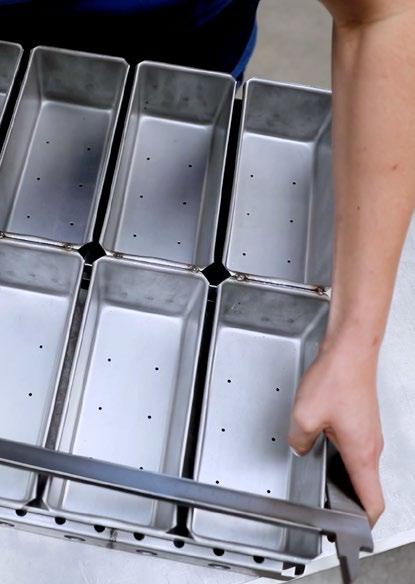
peeled off while cleaning the tray with various cleaning agents.
Kempf added KeyBAKE Bakeware & Coatings to the group at the beginning of 2023, around the time when construction for the expansion project was starting in Germany. Perforated (bun) trays make up its main business, with a portfolio including bread pan straps, baking trays, baking forms, peelboards, coatings and racks. With a team of 35 people, it is also actively hiring, as it is increasing its production capacity to a two-shift operation. KeyBAKE is mirroring Kempf’s growth; coincidentally, it also relocated to a bigger headquarters spanning 3,000 sqm in the Netherlands, in a newly-renovated building, in November ’23. With the move, it invested in several machinery upgrades, including a 2,000-tonne press that can make trays up to 2,000 x 1,200 mm from a single piece of metal – in line with the trend of increasingly using bigger baking trays.
New HQ is more than the workplace for Kempf’s team,it’s a place where they now enjoy many new process automation upgrades; it is also a meaningfully thought-out socializing space, where everyone can feel they are appreciated and equally belong. People who work and celebrate together stay together: in a series of in-house events celebrating the new facility, employees can show family members around so they can see for themselves last year’s work in person, which came in addition to their day-to-day tasks.
Everything was planned in detail around the building itself too, with scenic areas including selected trees, and functional parking and loading/unloading spaces. If required, there is still adjacent land available for further expansion in the long term, when the time comes. +++
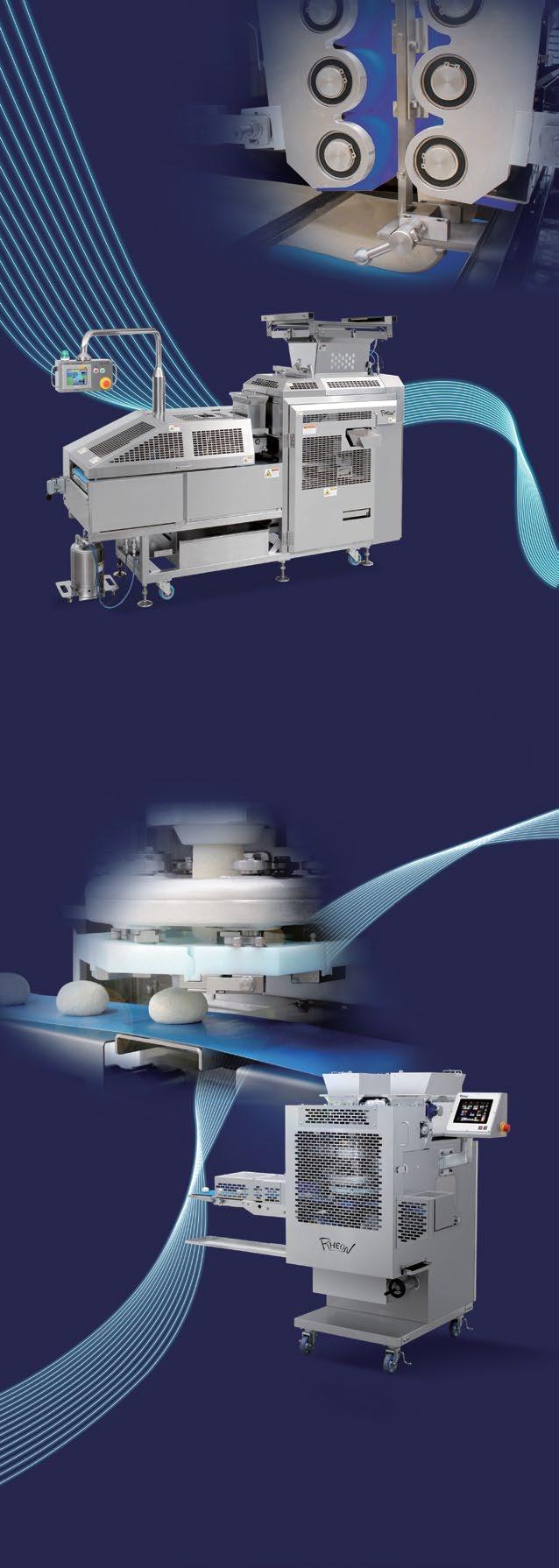




Dough folding, dough rolling and, most importantly, dough separating: the quality of several product ranges relies on perfect, consistent laminating and sheeting. Achieving the desired number of layers in the exact thickness desired, for the optimum characteristics of each end product, can be just a matter of setting up the right production line correctly.
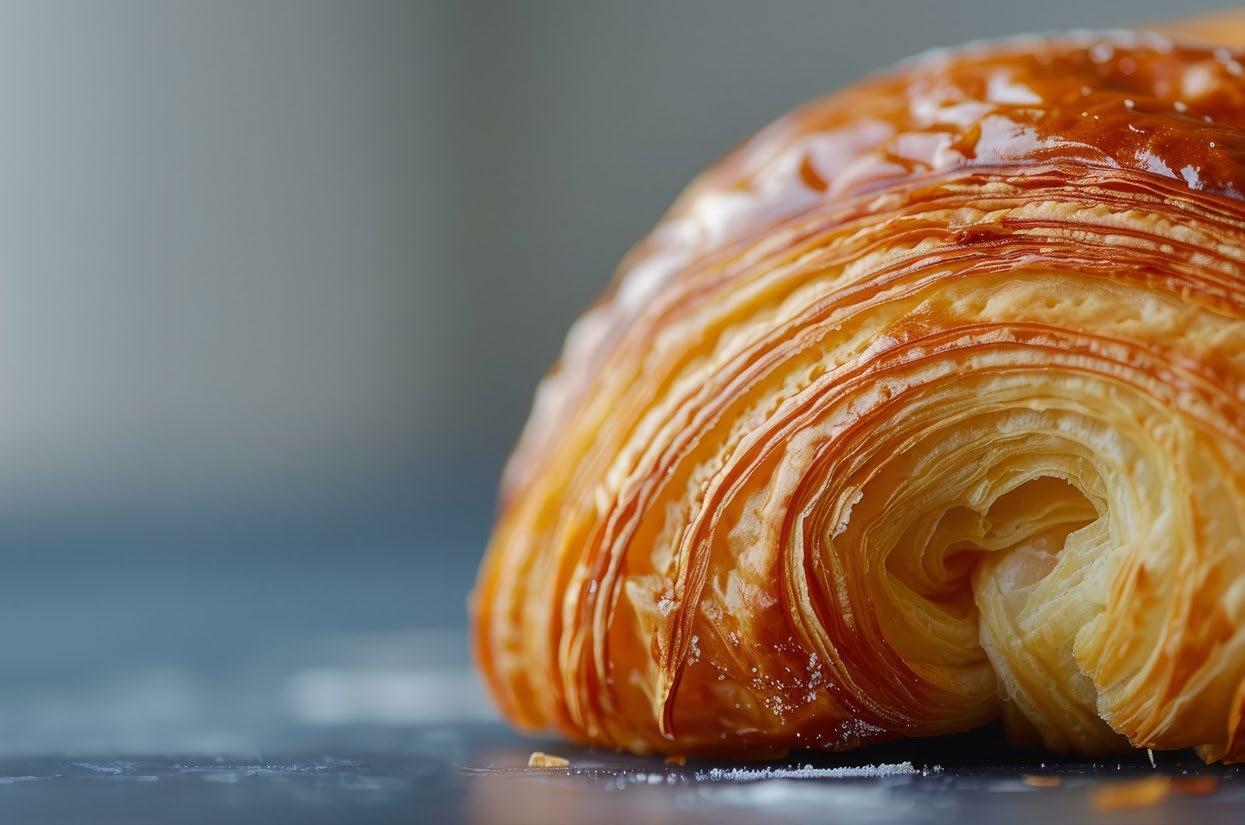
+Production lines for sheeting and laminating dough are usually built around the characteristics of certain product ranges, which are in production at a certain point or are planned to be introduced. However, this equipment can have the flexibility to support changes regarding the look, feel, shape and style of products. Having in mind the ability to provide any conceivable possibilities with mini mum physical and financial effort, AMF Bakery Systems is focusing on increasing the flexibility of its sheeting and laminating equipment by having quick changeovers, to minimize downtimes.

“Engineered with the master baker in mind, AMF Bakery Systems’ dough sheeting and laminating technology is developed with a focus on sanitary design to facilitate easy and low-maintenance operation.”
Lex van Houten, Marketing Manager, EMEA and APAC, AMF Bakery Systems
Automation is not just a time- or cost-saving feature for this stage; in line with any other station on the bakery floor, the lack of skilled bakers and operators is a major challenge for dough forming, too. Automated equipment can, by and large, make up for missing staff, or for assigning the team to more meaningful tasks. “This is why our level of automation can help bakeries grow their productivity with
changeovers that do not need any tools to be carried out, we have recipe-driven production programs, so that very little time is required from an operator to run the line,” highlights Lex van Houten, Marketing Manager, EMEA and APAC, AMF Bakery Systems.
New and improved sheeting and laminating line design: AMF Tromp technology
While challenges related to high (and then higher) production volumes are, to a great extent, under control, today’s to-do list in automated equipment prioritizes food safety, hygienic design, cleanability and sustainability. AMF Tromp laminating and sheeting systems have been updated around these considerations, while maintaining
complete process control and high output rates via intuitive recipe management systems for a variety of products, with unique shapes, sizes, decorations and inclusions.
“Engineered with the master baker in mind, AMF Bakery Systems’ dough sheeting and laminating technology is developed with a focus on sanitary design to facilitate easy and low-maintenance operation. The open-frame construction of our dough sheeting equipment allows for full wash-down sanitation, ensuring that hygiene standards are meticulously maintained,” the specialist highlights. At iba 2023, the company showcased its latest advances in hygiene for sheeted bread lines, incorporating a new sanitary design and “revolutionary new features for stress-free, gentle dough sheeting, reduction and handling of highly-hydrated doughs,” the technology specialist described.
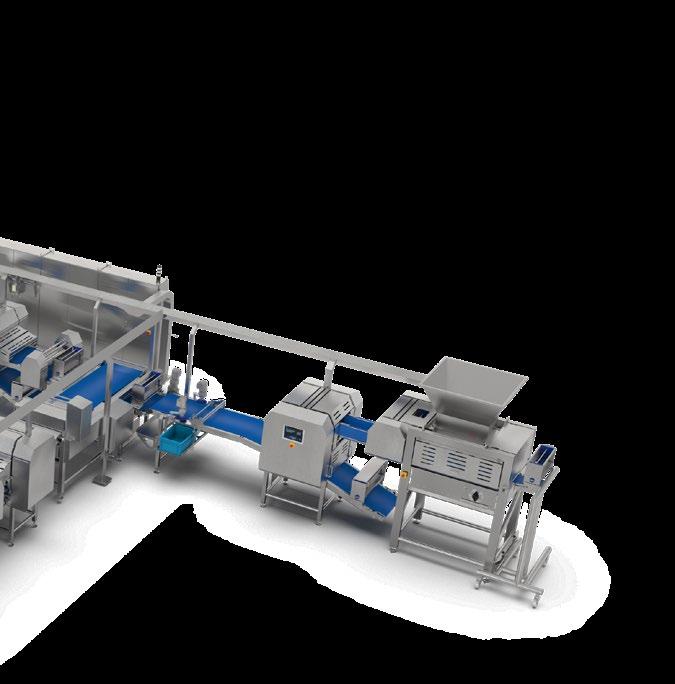
volumes and corresponding massive factories, a sign that the industry has understood the assignment and is preparing to meet a rising demand for baked goods. Numbers justify the trend: currently, the world population is 8.1 billion, and this will have risen by 73.4 million before the year ends; the world population should reach the 9-billion mark in the next 13 years and is expected to grow to 10 billion by 2057 1
“Luckily, healthy food options that are in demand, such as gluten-free, bio, vegan, and many other trends entering the market can also be produced with the same kind of
1 Source: https://www.worldometers.info/world-population/. Accessed: May, 2024.

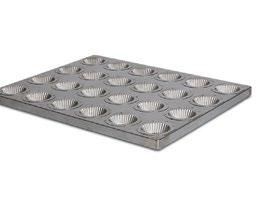


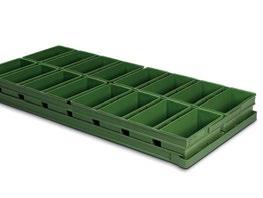

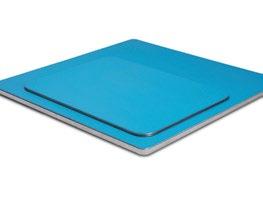
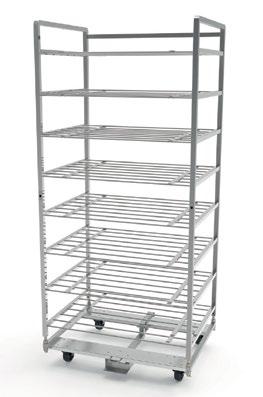
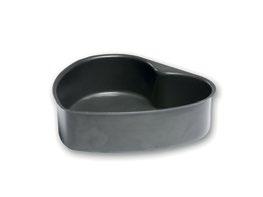

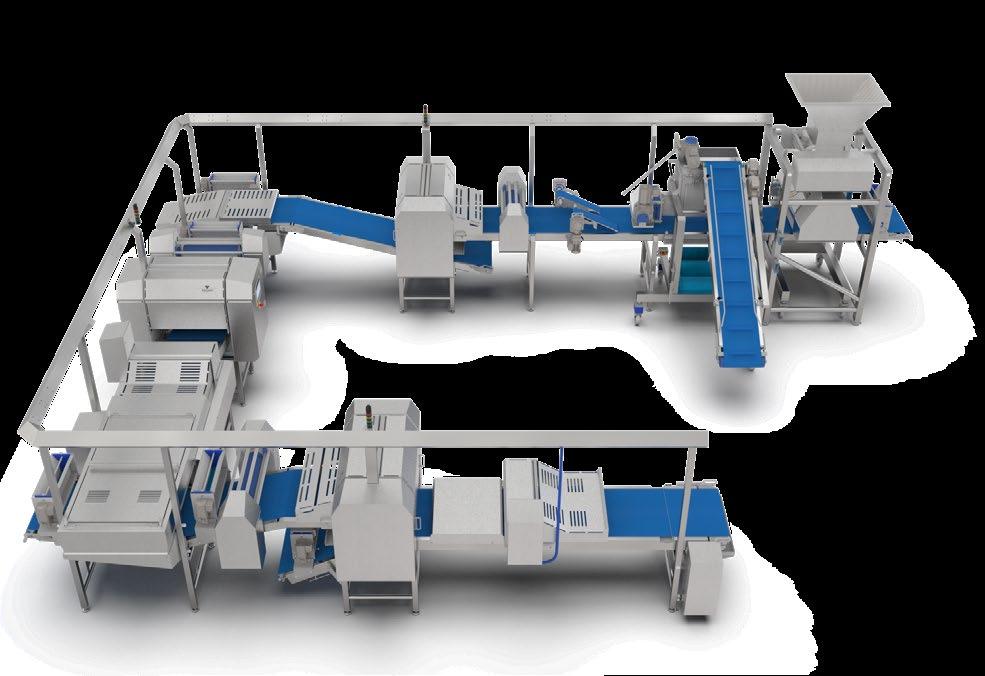
laminating technology that is today used for an already extended range of goods,” van Houten explains. So, these systems can turn profitable quickly. Adding additional features can open the door to even more product choices: a Tromp depositor can be used for various fillings in pastry snacks, sweet or savory, vegan or meat-based.
For practical purposes, laminating lines are usually designed in an L- or U-shape, so that the layer creation and laminating process are set up on the corners of these layouts. It is a setup that works best for the production of many types of laminated dough, including Dutch and French crust. But, a block laminator is also an option, which is usually employed to pre-fabricate blocks of laminated dough, which will be sold as such or are used in the production of pastry products on a different line, the specialist from AMF shares the alternatives available.
Possible setups can vary significantly from one region to the next, each with its specific traditions; AMF automates processes on systems that meet these requirements. While the equipment integrated on an AMF laminating and sheeting line may vary according to specific builds, a fat or butter pump is a mainstay. An extruder is another popular addition, as a method of creating the dough sheet.
Dough band-forming solutions adopted may vary, as it will always depend on the products the system will make, as to whether the dough needs to be extruded or sheeted, or whether it contains fat or it needs to be applied and folded into layers. Laminated dough can be created at high speeds and volumes, with as many as 1,000 layers if
Several parameters are critical to achieving optimum results, including the temperature of the bakery, the temperature of the dough itself and the temperature of the fat. The AMF Tromp butter and fat pump is able to maintain product temperature and moisture consistently, with little stress to the fat, ensuring its integrity is maintained while it is applied to the dough. “No piping is used, so cleaning is easier, and no crystallization takes place in the process,” the specialist explains. The pump is built on a C frame so it can easily be wheeled in and out to be integrated into the Tromp (and any other) laminating line.
It can handle a large variety of fats, including margarine and real butter, but also newer alternatives such as vegan, or bio varieties. “We tested this with our ingredient partners from the industry, such as BUNGE, and they are quite happy with the results,” van Houten underlines. When working with butter, using low pressure ensures that the fat remains intact and water will not be separated while it is pumped onto the dough.

The Tromp laminating lines keep the entire process under complete control, by using recipe-driven software and controls. Different automation levels are available, starting from semi-automatic pastry/laminating lines, when a baker is responsible for a small make-up line, scaling up to fully automated systems usually found in high throughput production facilities. For the latter, AMF can build complete systems that include laminating and sheeting processes, starting from mixing through to baking, cooling and freezing.
This technology always has room for growth, both to increase production volumes and product ranges that are made with it. The expansion will be defined case by case, as floor space is also a part of this equation. This aspect is established in the first design conversations, regarding the products that are immediately intended and including any ‘wishlist’ ideas. New features can be added as production expands.
Introducing the new 893 C.
Closing up to 120 bags per minute with state-of-the-art motion control, ethernet, and wireless communications, the speedy 893 C Automatic Bag Closing Machine has efficiency baked right in. LEARN MORE AT KWIKLOK.COM






















































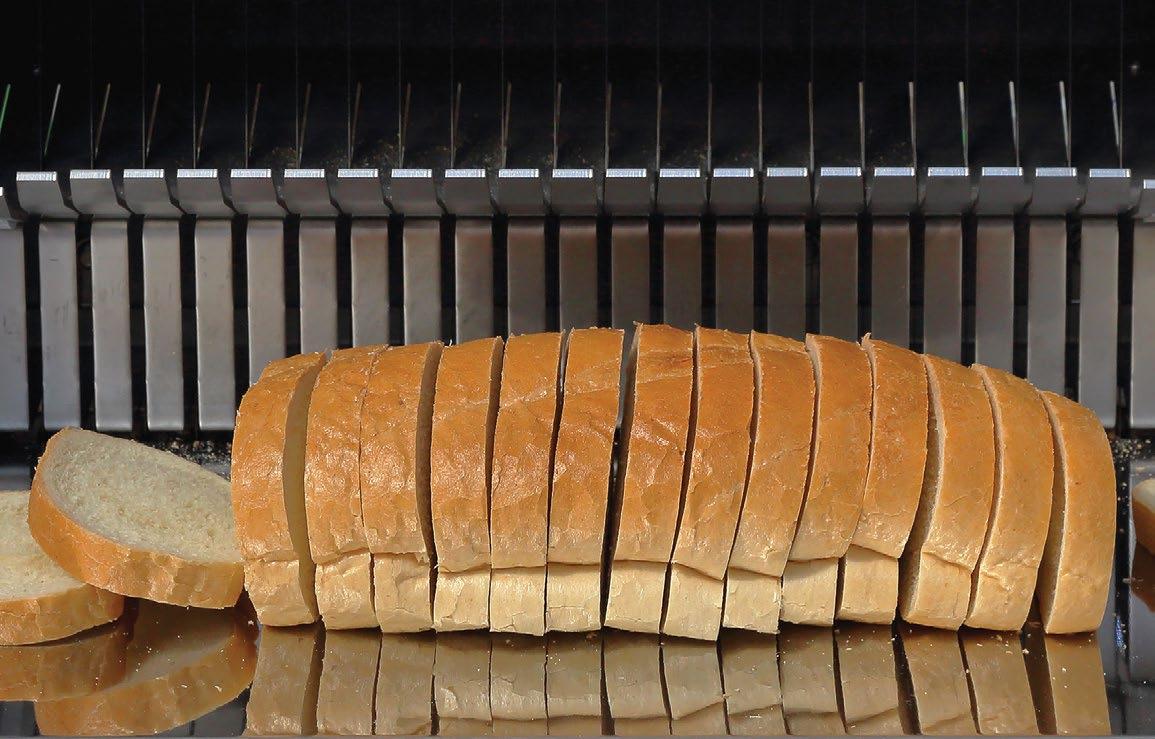
Correct and consistent dough dividing will amount to valuable material savings over time. At this stage, less (extra dough unnecessarily going in every product) is definitely more (process efficiency).

+Every gram of raw material going into bakery products in excess of the intended product volume adds up to considerable amounts lost throughout the year. The bigger the production rates, the more room for significant material and margin loss – without any added benefits to the ‘extra generous’ products. True-to-life accuracy in dough dividing is the answer to this problem.
The Mini Rex Multi, an entry-level machine developed by Koenig to support automating production, is one solution that excels at dividing and rounding dough consistently and also covers a very high range of weights: from just 8 g up to 330 g per single dough piece. The dough pieces can be round-molded from 8 g to 150 g or unrounded up to 330 g, which means it can offer a wider range of applications in terms of weight. “The machine achieves this thanks to the innovative interchangeable ‘Multi‘ system: stamping ledges with 1 – 4 rows can be combined with matching, also interchangeable rounding plates to achieve the desired weight ranges and rows,” explains Robert Sauseng, Design Department Team Lead – dough dividing and rounding, Koenig. The new compact divider has a total output of up to 1,200 pieces per hour for single-row production, and 4,800 pieces per hour when they are made in four rows. The switch between products of different weights can be made in a few minutes. Afterward, the desired program is selected on the display interface. The weight range can be defined and set up for each stamp size using a handwheel. Different weight ranges can be made by exchanging stamping ledges. Interchangeable rounding plates are available for each row. “The Mini Rex Multi runs in a continuous, one-man operation and therefore offers greater
“We achieved its compact design by arranging some of the work processes one above the other, such as the dough feed, which is positioned above the dividing area. Round molding takes place directly on the dividing drum.”
Robert Sauseng, Design Department Team Lead – dough dividing and rounding, Koenig
efficiency than a conventional grinding machine,” Koenig highlights, featuring a roller feeding hopper for approximately 15 kg of dough.
When designing the Mini Rex Multi, the development team also focused on space-saving, to occupy the smallest possible footprint. “We achieved this by arranging some of the work processes one above the other, such as the dough feed, which is positioned above the dividing area. Round molding takes place directly on the dividing drum. After molding, the dough pieces are immediately transferred to the outfeed belt with the support of a take-off roller. This direct process saves additional space while at the same time being gentle on the dough,” Koenig specialists explain the solution they found.
The Mini Rex Multi receives the dough manually into the feed hopper. Integrated flouring of its dough feed rollers ensures the material will travel through without sticking. Next, star rollers portion optimal portions into the weighing area. Depending on the selected weight range, the level of

dough in the weighing area is automatically adjusted with the use of an optical sensor. A horizontally movable dough pusher presses the dough into the openings of the dividing ledges, and the surplus dough is gathered by a scraper and conveyed back into the dividing area.
The dividing drum is then rotated at a 90° angle, allowing the dough pieces to be round-molded with an oscillating rounding plate. “The speed of the rounding plate and the deflection of the rounding eccentric can be adjusted for optimum rounding results according to different dough consistencies and weights,” Koenig specialists explain. The dividing drum is equipped with four identical dividing ledges. The machine can have the drum bars and rounding plates easily changed to achieve a wide weight range, allowing ample product variety.
The Multi Rex Mini can be used as a stand-alone machine and have the dough pieces discharged onto a continuous outfeed belt. But, it can also be used with a forming station – in this setup, the divider is mounted at an angle to the forming station and the dough pieces are discharged onto a spreading belt. The forming station can be used to produce hamburger buns, hot dog buns, milk buns or even teleras, plaited buns and bolillos, Koenig illustrates: “The dough pieces are pre-rolled on the infeed belt of the forming station and stamped accordingly on the forming station.” Baguettes and toast bread can also be produced in the higher weight range. In this setup, the system can
process wheat doughs and mixed doughs with up to 20% rye. The dough yield ranges from 148 to 162, depending on dough.
Various other modules made by Koenig can be added to the Mini Rex Multi to achieve an even greater variety of products and even configure a full, compact bread and roll line. “In addition to the forming station, a compact seeding station can also be integrated, or a convoluting station. For stamped and sliced products, the system can be supplemented with a G2000 proofer system with a stamping station for round products weighing 30 - 75 grams and a slicing unit for long-rolled products weighing up to 85 grams. The GS2000 proofer even offers up to 220 filled swings and also the option of stamped or sliced rolls,” Koenig specialists detail.
Hygiene and easy maintenance were also considered in the Mini Rex Multi’s design: the components that come into contact with the dough are conveniently accessible, so they can be easily cleaned. The roller hopper and the weighing hopper can be opened from the operator’s side without tools. In addition, certain parts can be removed for cleaning; and the entire machine is made of stainless steel for hygiene and durability.
The machine is part of Koenig's ‘Self Installation’ series. Detailed video tutorials are available for safely unpacking, assembling, installing and starting the machine, as well as for regular cleaning and maintenance. Specialist services can also be included, provided by Koenig specialists who will install and commission the machine on location. Once the new Mini Rex Multi has been comfortably seated, it can begin its work alongside the bakery’s team on a comprehensive range of products. Bakeries often start to automate and optimize their production with the Mini Rex Multi and while the bakeries are growing, they are growing with the equipment, Koenig observes. Its dough dividers and rounders can reach capacities of up to 50,400 pieces per hour. +++

An entire fleet of iconic crackers built its consumer base on their open, flaky texture, which is produced by layering the dough. Reading Bakery Systems designed a new, 90-degree technology concept for the laminators manufacturing this dough.

+Accuracy over time is essential to creating consistent sheets of dough that will then be cut and baked, to become enticing cracker products. The end result relies on stable processing and process efficiency. Technology needs to provide both. For cracker manufacturing, laminating dough is one of the key steps that immediately influences the end product characteristics. Lamination provides a slightly expanded structure, often characterized as a tender bite. Because most laminated crackers have a fat content of several percent, the crackers become softer in texture.
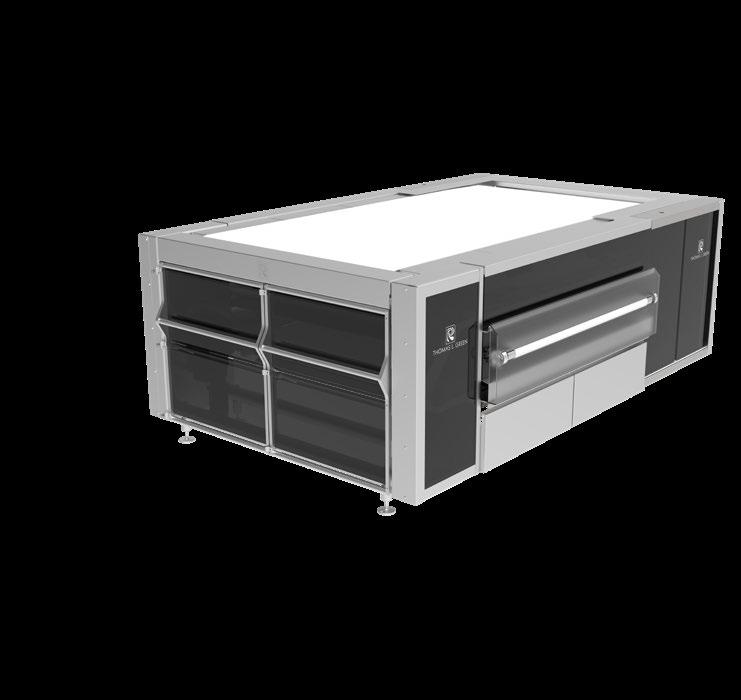
“Most laminated sheeted crackers will receive between four to eight laminations. Process speeds can vary from 10 to 50 meters per minute.”
Cameron Johnston, Senior Director of Innovation, RBSSpecializing in solutions for the automated, large-volume production of virtually any type of cracker product, Reading Bakery Systems (RBS) recently perfected a new laminator design that answers multiple processing needs. The latest design in the company’s Thomas L. Green equipment is a 90-degree laminator that is suitable for any traditional, wheat-based cracker dough, as well as non-traditional doughs. The straight-angle layout offers a shortened footprint, which is great news for saving valuable floor space. The compact design is especially useful when plants already have tight room between processing lines, while also handling the dough gently. Machine uptime and hygiene features were also improved: “Our frame design has a more open construction for ease of sanitation and maintenance. Most bearings have routine greasing services that can be completed while in operation, allowing for longer production runs between shutdown maintenance intervals,” explains Cameron Johnston, Senior Director of Innovation at RBS.
+ A dough sheeter may be installed to the side or directly above the laminator for a compact and efficient production layout
+ Multiple configuration options are available, depending on product ranges and available plant space
Before arriving at the laminator, the dough sheet is first created, usually with a three- or four-roll sheeter. The initial sheet usually ranges between 4 mm to 10 mm in thickness. The dough sheet is transported onto a turning conveyor, which gently rotates the sheet to 90 degrees and then places it onto the laminator infeed conveyor.
Lamination speeds with the new machine can vary greatly, so the process always correctly matches the requirements coming from variations in the number of dough layers. If fat flour is used, it is applied between dough sheets to impart distinct layers. “Most laminated sheeted crackers will receive between four to eight laminations. Process speeds can vary from 10 to 50 meters per minute,” the specialist separation of individual sheets.
says. Downstream equipment and related processes also influence laminating speeds: the oven’s length and baking times are among these factors.
For flexibility, the laminator can come with a bypass feature, so that it can allow the system to produce both laminated and non-laminated crackers. “This is extremely helpful for expanding the number of sheeted snacks capable of being produced on a single line,” Johnston highlights. The new laminator processes dough with precision, from receiving to stacking and delivering the sheeted dough to the discharge conveyor, for reduction and forming.
The new design also makes cleaning easier. Cleaning can be carried out by simply opening the guards and brushing or blowing off any debris. A damp cloth should be used to wipe down interior and exterior surfaces, belting and belt scrapers, RBS recommends. Common sanitation chemicals may be used on surfaces coming into contact with the product.
Crackers make up a creativity-filled segment of snacking options, with all signs pointing to further growth. Market

figures already paint a vibrant picture: 75% of the people surveyed for the latest ‘State of Snacking’ report by Mondelēz International say they consume snacks during a special moment of the day, and 59% of them declare themselves to be ‘snacking adventurers’ who are open to new proposals. As people increasingly favor quality offerings, technology updates bring new features, leaner processes and more capabilities. Combined innovation on the side of the technology developer and the user is key. +++








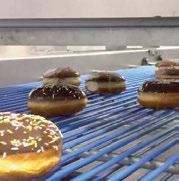




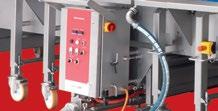



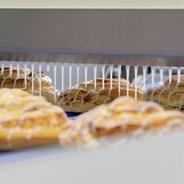






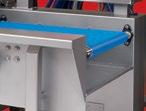








Automated production lines are the solution to optimizing production and optimally allocating resources, including a critical one: the people on the production floor. Designing the turnkey line that fits best with a given environment throughout each process step also starts with people: the design team tasked with bringing together only the perfect pieces of the puzzle that will become a new line.
+Turnkey lines integrate solutions, often from different suppliers, to work together on specific requirements. Finding the right suppliers with the most suitable equipment, who are also open to working together, is critical. The task of the project design team is to ensure good process transitions are arranged between them, while it manages communication between suppliers and controls the automation of the turnkey line. To avoid any compatibility issues that may arise, the specialists managing the design project focus on ensuring each supplier has a clear insight into the scope they cover in the project and understands all its details around critical milestones.
Given the task of building a turnkey line for maximum flexibility around the types of breads and rolls it can produce, its functional specifications are defined together with the baker. Douglas Hale, Director of Systems Integration North America at Rademaker, explains how such a project is kick-started: “We partner with the customer, starting with a detailed process flow that describes all of the different products and their specifications. Many times, the customer does not have all that information in the design phase, so you need to build into the design the ability to modify and adjust for the unknown.” Packaging is the more difficult area to set up, in their experience.

“Due to this modular architecture and often customer floor space constraints, multiple units can be delivered in a mobile variant to cater to production needs.”
Olaf Stok, Product Manager Bread Lines, RademakerThe initial list of requirements is closely analyzed and managed by the turnkey specialist in close communication with the baker, while the overall design is created, managed and agreed on. Flexible planning is key to flexible lines, as differences in initial views on the project are not uncommon: “Many times, what the customer wants will either not fit and/or work within the budget constraints so meeting regularly helps the decision process go faster and keeps the project schedule moving forward,” Hale points out.
Comprehensive testing is then carried out in the design stage at Rademaker’s dedicated facilities. If the project entails processes new to the bakery, testing will validate the design and ensure the product’s characteristics are on target.
“Many times, what the customer wants will either not fit and/or work within the budget constraints so meeting regularly helps the decision process go faster and keeps the project schedule moving forward.”
Douglas Hale, Director of Systems Integration North America, Rademaker
For a smooth installation process and timely startup, the entire project team takes part in the line design phase: the installation project managers together with those in charge of controls and commissioning. Once the design phase is completed, the formal quoting is submitted, which is used as the basis for the project’s milestone dates. Rademaker works with all suppliers who are involved in the project to map out the progress and, ultimately, the commissioning date. At the same time, its project management team also works closely with the bakery, as they assess the current process flow and product ranges. They may even spend some time in the facility to better understand the standard practices and the production team’s level of expertise. At this stage, they also assess if there is an established training process in place at the facility: “If needed, we can provide the customer with training for the Rademaker equipment, provided by the Rademaker Academy. The project managers are able to provide mechanical training on other pieces of equipment that are not made by Rademaker,” Hale explains.
A flexible line needs to also be update-friendly, for additional features that can be integrated at a later time, to expand and/or upgrade the line. Rademaker turnkey lines are created to be flexible, especially in sections such as packaging and pan handling. “Helping the customer to consider the future and what those changes would or could look like is something that we do in the design phase. Showing theoretical future lines or future expansions as part of the overall layout is something that is requested many times,” the American system integration specialist details.
In the scenario of a project designing an industrial bread line, Rademaker’s bread line is incorporated, meaning that its modular architecture can readily support revisions long after its initial build, so that production stays ahead of (future) consumer needs with incremental technology revisions. “Due to this modular architecture and often customer

floor space constraints, multiple units can be delivered in a mobile variant to cater to production needs,” Olaf Stok, Product Manager Bread Lines, points out. Fast changeovers are also an important part of this plan, and are also supported by the modular design. The flexibility of this line comes at no expense to its efficiency: “Our focus on ingredient optimization (if applicable) and waste reduction ensures maximum efficiency throughout the production process,” Stok adds.
There are several options – and challenges – when upgrading an existing turnkey project. For example, system integration becomes more complex and the resulting line will require more floor space when working with multiple types of pans, peelboards and/or baking trays. “Think about changes from one type of pan to another, or switching to trays. This can be done manually or can be fully automated. Then, add to this equation stacking robots and storage for different carriers. These solutions will claim additional space in the layout and need to be well organized in the daily production planning, illustrates Dennis Everaers, Bakery and Process Technologist at Rademaker. The company also provides solutions to such considerations in their turnkey projects.
When a newly designed line is completed, it is always set up first in the assembly hall in Culemborg, in the Netherlands. Test runs are carried out to verify that expectations for product design are met. A Factory Acceptance Test (FAT) is done with the line’s new owner, to confirm that all their requirements are met. This step is unique to Rademaker, according to its systems integration specialist. Multiple lines can be assembled at the same time (detailed scheduling is planned).
The last stage, the arrival of the new line at its final destination, in the production area, also requires careful planning that needs to consider how to minimize the impact on the daily work, so that production continues throughout the installation process. “This is a challenging area. We help the customer with plans to isolate daily production from the area where the new process is being installed,” Hale details. The Rademaker Integration team is trained and certified in food safety and can run daily process checks, to ensure safety and smooth operations during the building phase.
Soft dough biscuits are among the popular snacking choices worldwide. Their success comes, in no small part, from their diversity, combining flavor offerings and playful shapes. Recipes may call for inclusions or enrobing, to further expand the variety of this exciting product segment. Flexibility is a must for the corresponding technology to support this level of creativity.
+Inviting with their diverse iterations, biscuits are, nevertheless, a delicate business to master. Following careful preparation, the fragile products are thoroughly inspected so that they may begin their journey to the consumer in great condition, and remain that way until snack time. The competition for attention matches their diversity, which is, at the same time, their unique selling point.
New Era Machines designs and develops turnkey industrial production lines for molded soft biscuits. This line was developed with the purpose of maximizing production versatility, the specialists of the Indian company highlight: “Through extensive research and innovation, we engineered the line to accommodate a wide range of dough consistencies and formulations, allowing for the production of various biscuit types.” The line’s flexibility is achieved by incorporating adjustable parameters and versatile machinery components, they explain, to accommodate an extensive array of biscuit products and achieve the desired end-product quality.
The line comes with a modular feeding system, specially designed for biscuit production. It offers several benefits, starting with streamlining the dough feeding process. This is done by automating the distribution of dough to the forming system, which reduces manual labor while also ensuring consistent dough quality and accurate portioning, resulting in enhancing product uniformity. Additionally, the modular design means that the line can be easily customized and scaled, facilitating seamless integration into existing production setups and accommodating future expansion needs. The design of this line’s forming system also takes into consideration diversity in product demands. “We learned from the operators and customers running our machines for decades and have employed all the features necessary for quick changeovers of the molding roll and the endless belt, as well as variable speed settings to meet the process requirements and a wide range of baking times,” according to the specialists from New Era Machines. Customizations are also possible; for example, the machine can be built so that it is suitable for wash-down cleaning.
The New Era lines for soft biscuit production can also integrate equipment with various techniques of applying inclusions. They are equipped with precision dosing systems and deposition mechanisms to accurately deposit

inclusions such as salt, sugar, sesame, or nuts on the surface of the dough. Next is the oven – arguably one of the most scrutinized pieces of equipment on a line. For the production of soft biscuits, convection technology is widely the oven of choice, for its baking efficiency. As care for resources spent has become a ubiquitous concern, New Era observes that hybrid ovens have become the most popular request. The company meets this demand with its oven technology, which is designed to optimize energy consumption and product quality: “By combining direct heating and convection, our hybrid ovens provide precise temperature control and rapid heat transfer, ensuring consistent baking results with minimal energy usage. Additionally, advanced insulation and airflow management features further enhance efficiency, reducing heat loss and maximizing oven productivity,” the specialists describe.
“By combining direct heating and convection, our hybrid ovens provide precise temperature control and rapid heat transfer, ensuring consistent baking results with minimal energy usage.”
New Era Machines specialists
Hygiene and product safety are also high on the priority list, with a decisive uptick over the past few years, which is reflected in equipment R&D. The latest developments in line design at New Era Machines prioritize hygienic design principles and product safety standards: key features include smooth, easy-to-clean surfaces, sanitary construction materials. “Our machines are also equipped with advanced safety features such as interlocking guards, emergency stop buttons, and comprehensive safety protocols to protect operators and ensure compliance with industry regulations. Based on the installation country, CE, UL or CSA can be certified,” the specialist highlights.
Optional features that can be added to New Era biscuit production lines include customized decorating systems, automated packaging solutions and custom solutions for specific requirements.
The lines can be designed to evolve together with the manufacturer and keep up with later plans for additional

product ranges. For instance, if a manufacturer is installing a soft biscuit line today but wants to keep their options open and also be able to produce hard biscuits in the future, several features can be considered from the initial design stage, including necessary space for future expansions, oven technology suitable for both hard and soft biscuits, the technology specialists illustrate.
Process controls play a crucial role in ensuring consistent product quality and operational efficiency. New Era Machines biscuit production lines are equipped with control systems that monitor key parameters such as temperature, speed, and power throughout the production process. These controls enable operators to make realtime adjustments, optimizing production parameters and minimizing waste. Additionally, comprehensive data logging and analysis capabilities allow for continuous process improvement and quality assurance.
To achieve a balance between product diversity and optimum process efficiency, careful planning is required.
“To maximize efficiency without sacrificing product variety, manufacturers should focus on streamlining production processes, optimizing equipment utilization, and investing in flexible machinery solutions,” New Era says, recommending the implementation of modular production systems, standardized workflows, and advanced automation technologies, to ensure production adaptability. Additionally, continuous monitoring and improvement of key performance metrics can help identify areas for optimization, they note.
The newest developments in biscuit production machinery at New Era focus on enhancing performance, flexibility, and sustainability. Key advancements include improved automation capabilities, enhanced energy efficiency features, and fine-tuning technology for product innovation and differentiation. +++
FOR YOUR PERFECT BUNS.

MODULAR LINE IN EASY CLEAN DESIGN Artisan SFM EC Dough Sheeting Line
The Artisan SFM EC stands for gentle dough processing and efficient working. You can process both fine and large-pored doughs with a high water content. There are no limits to what you can do: whether you want to make corn corners, round rose rolls, ciabatta or bread - you can process doughs from a dough consistency of 160.
FOR OPTIMIZED CLEANING Easy Clean Design »EC«
Save valuable time for cleaning and changing products. The innovative „Easy Clean“ design with its new frame structure ensures optimized hygiene and accessibility.

From the beloved classics to the unexpected modern creations, the finest viennoiserie and puff pastries enjoy unwavering commitment from consumers. Along with the enthusiasm around all things patisserie, expectations are also rising.

+The love of pastry and viennoiserie products is unbothered by cost-of-living worries; on the contrary, the appreciation for fine bakery is growing, as it provides an important moment of indulgence and affordable luxury, when other experiences have had to leave shopping lists. The global pastry market, in which Europe ranks first, is estimated to be around EUR 61 billion this year, and projections show it could reach EUR 72.27 billion in five years – a CAGR rate of 3.44% . Consumers increasingly expect unique flavors, premium ingredients (including healthier options and sustainable options), innovative recipes and craftsmanship, regardless of the type of shopping channel at hand.
Specialized equipment that allows close control of the entire manufacturing process is a considerable advantage in industrial bakeries. How to mass-produce delicate creations that look, feel and taste on par with hand-crafted offerings? Dedicated lines are involved. Looking at the endless product possibilities, a flexible line is needed, to answer various production demands, while also ensuring accuracy with no exception.
Bringing French flair to viennoiserie and French technology into production, MECATHERM offers a concept line that can help manufacture many types of viennoiserie (and other products such as morning buns): the Mecacroissant production line, with equipment covering all processes from proofing to cooling and freezing. The company develops solutions that reliably produce croissants matching the French product quality standard.
The line ensures smooth handling of the product throughout its processing cycle, to guarantee its iconic shape is preserved. But, MECATHERM also tailors this line to meet the product characteristics of any international product range in this segment. Besides the traditional flaky French croissant, made from laminated Danish dough, a very popular trend in Eastern Europe is the brioche dough croissant, for example. Both of them can also be topped or filled, which brings additional challenges in industrial production.
“The software plays out different production scenarios on the 3D model of the manufacturer’s production line to help them achieve the best availability rate and the lowest changeover times.”
Mecatherm specialists
The Mecacroissant line can be adapted to run as a multiproduct line, as the machines in its setup are suitable for different types of products. The M-TA tunnel oven is designed to support extended product ranges with precision; the same goes for the M-UB proofer, which is also suitable for a wide range of products, including the most delicate ones, with any type of filling. Mecacroissant lines can produce up to 35,000 baked regular croissants per hour.
François Retailleau (Production Lines Manager), Fabrice Bourion (Equipment Product Manager) and Xavier Gotti (Ovens Product Manager) share MECATHERM’s perspective
on processing pastry and viennoiserie products and how to utilize the Mecacroissant to fully make use of all its benefits. This production line is adapted to each project and to the products, processes, constraints and production rates of each manufacturing site, the specialists explain. The process stages may remain unchanged for all types of viennoiserie; however, perfecting each specific product is in the details, with parameters to match their size and unique profiles.
For example, proofing times can vary: they are usually longer for long shelf-life products – which can take up to eight hours – compared with frozen products, which only require two hours for proofing. This process step poses challenges to preserving product characteristics; the proofing temperature must not be too high, so that it doesn’t alter the fat, and the proofing time must be adapted to the desired shelf life. MECATHERM credits the M-UB proofer and cooler for smooth product handling, which is essential to preserving the unique shape of delicate viennoiserie such as croissants.
In a different scenario, if various types of products need to be produced on indented or flat trays, the equipment will be similar in both cases; but, the operators will have to change the trays between batches. “To make this operation fully automated, we can add a storage gantry to the production line, which can manage several sets of trays,” the specialists add.
The Mecacroissant can also be adapted according to the process required by the final product. “For a product with a long shelf-life or premium quality products, it is important to be able to precisely adjust the baking curve and the heat transfer mode; the M-TA oven is particularly adaptable for that, for example. On the other hand, to optimize industrial performance, footprint and energy efficiency, the vertical oven is a very good alternative,” MECATHERM ’s team illustrates. The oven’s baking curve can be adjusted by fine-tuning the heating mode (radiation or convection):
+ To obtain the expected crust coloration: color contrast or even coloration
+ To customize the texture and volume: from crispy to flaky, with a more or less open crumb
+ To manage the moisture content (which impacts the product shelf-life).
The production of viennoiserie, and, in particular, layered pastries filled with cheese or meat, is a considerable endeavor in terms of hygiene, as these ingredients come with strict requirements. “To meet these challenges, the M-TA oven can be equipped with an access window for easy cleaning and a stainless steel belt to reduce clogging. With these options, it becomes an excellent solution for products that require a high level of hygiene, as it provides very

precise and flexible baking in a full wash-down oven. Its hygienic design makes it especially suitable for the production of sensitive products,” MECATHERM’s specialists explain.
Flexibility is also a major challenge to be addressed when manufacturing fine bakery, and is particularly reflected in the baking process, respectively the oven technology behind it. “To meet this challenge, we recommend the M-TA oven, which is very flexible thanks to its very precise and customizable baking curve. It allows manufacturers to produce even the most demanding clean-label products, formulations that have no additives and are made with natural ingredients, as well as free-from and better-for-you product ranges (such as gluten-free, or wholemeal recipes) – both important trends in the viennoiserie market,” MECATHERM’s team underlines. The M-TA is also the best oven choice from MECATHERM's range when producing a diverse range of products or when a precise adjustment of the baking curve is needed, as it features independent baking zones. “The adjustable parameters make it possible to have either convection or radiation at the top or bottom,” MECATHERM’s specialists highlight. The hygrometry can also be adjusted on this oven, which is particularly beneficial for products with a long shelf life.
If the product requires convection baking only, then the vertical oven solution is the recommended technology – a compact solution designed to optimize industrial performance.
“In order to better manage the perfect hygrometry level in the ovens, both types of ovens are compatible with the Hygro Control System, which will be launched soon. This innovative solution will allow the automatic adjustment of the hygrometry inside each oven module independently,” MECATHERM ’s team explains.
Both of MECATHERM’s oven technologies come with a unique profile, a list of benefits that includes the potential for energy savings. The vertical oven significantly limits energy losses through its walls, conveyors and fumes, thanks to its compact design. Moreover, using convection means that

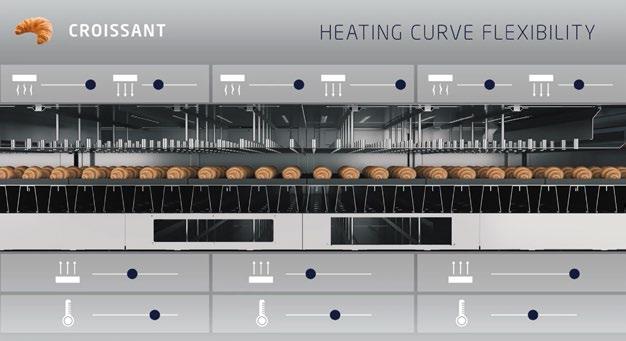
they can bake at lower temperatures, while benefiting from an even heat transfer around the product, again translating into energy (and time) savings.
MECATHERM is also developing new solutions to optimize energy consumption, starting with the Hygro Control system, which will offer automatic hygrometry management, reducing CO 2 emissions and energy losses due to fumes. The Energy Recovery System is another soon-to-be-launched solution, which will make it possible to save additional energy throughout the line by recovering the energy produced by the baking vapor and converting it into pre-heated dry air. The energy recovered can be used to preheat the oven with dry air, but it can also be used for other pieces of equipment along the line, including the proofer, the steam boiler, or even beyond the line, such as the building's hot water circuit. Moreover, “Most of MECATHERM ’s ovens will soon be compatible with an electrical heating source,” the specialists note, which will not only save resources, but will also limit C0 2 emissions.
The fill level of the oven and the production rate are also considered, so that the oven is heated accordingly: the parameters will automatically adapt, thanks to modular burners. “Our oven convection technology limits the flash heat effect thanks to the convection baking mode and a high rate of air renewal in the baking chamber,” the oven specialists explain.
Perfecting the baking curve for each product guarantees the best results with optimum resource allocation. Both of these priorities can be fulfilled along the entire production line, for increased sustainability in production, on one condition: that all processes are under complete control. Here, smart features play a decisive role.
For example, the pastry line can integrate the EYE-Q quality control system, developed by MECATHERM’s sister company, ABI LTD. The system is driven by AI to perform real-time quality control for every single product on the line – not
just samples selected at random every 100 items or every 15 minutes. “The EYE-Q classifies the products and provides a trend analysis to improve line performance,” the specialists explain. The smart inspection system can be positioned at any critical point on the line, such as depositing, where it can ensure that no double dough pieces are entering production and that each piece is correctly positioned at the center of the conveyor. Another possible placement is at the exit from the proofer, to inspect that the level of the dough rise is correct.
The greatest enemy of productivity is, undoubtedly, sudden production stops. The company can integrate a buffer on the Mecacroissant line to save production when such stops occur: it will store the products in the oven so the batch is not lost.
And this is not the only waste management mechanism that is utilized (on all MECATHERM solutions) to limit product loss. Most of the machines ensure smooth product handling, to avoid bringing any shocks to it (such as the M-UB handling system), and are designed to minimize necessary manipulations/transitions, to further avoid damage. Overall, “The precision of the equipment guarantees production homogeneity, limiting product losses,” the team adds.
Correct planning also contributes to baking more sustainably. The M-plan simulation tool can be used to optimize production scheduling. Its batch follow-up feature also allows for changeover management optimization and minimizing waste: “The software plays out different production scenarios on the 3D model of the manufacturer’s production line to help them achieve the best availability rate and the lowest changeover times,” they explain.
The setup of the Mecacroissant line supports product innovation, as it can easily introduce new creations into production. To optimize settings and formulations, new products can be tested at MECATHERM’s Demo Center in Barembach, with support from the company’s team of master bakers.

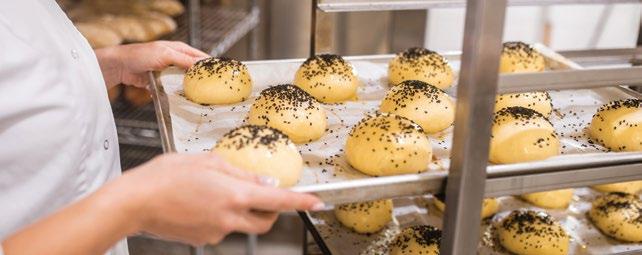
The global baking industry has many different standards for bakery racks and so do individual bakers. That is why we produce high-quality stainless steel racks made to meet the unique needs of each of our customers.
• Material: Heavy-duty stainless steel construction for strength and durability.
• Size: Racks made to fit any size pan or oven system.
• Frame: Variety of frame types from single, double, z-type, and more.
• Rungs: Use a standard amount and assortment or create a unique design.
• Castors & Wheels: Heavy-duty castors and wheels available in various materials with a range of features.
• Accessories: Choose accessories such as steering and fixings to meet your bakery’s needs.
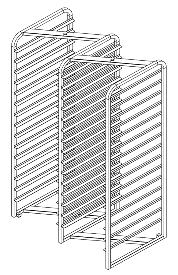


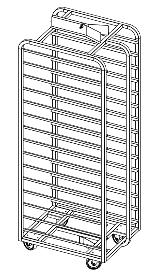
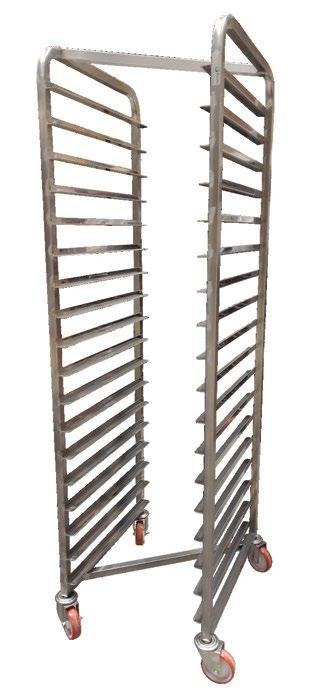
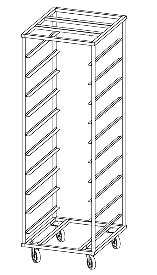



+Part of the French cooperative group VIVESCIA, Délifrance creates bakery, viennoiserie, pastry and savory products for foodservice providers, bakers and retailers. Founded in 1978, it offers its specialties in 100 countries.
Délifrance analyzed the bakery landscape and has selected the seven most promising trends set to shake up the sector in 2024, useful for inspiration when developing pastry and viennoiserie offerings. ‘Innovation’ is the name of the game, the company observes, as the use of the hashtag #innovation in bakery online has jumped by 136%, compared with the previous year 1
1 Bakery as an art form: Enjoy it with the eyes
In a climate where inflation is a major concern for consumers, there has been a significant rise in the popularity of high-quality and premium bakery products on social media. Taste comes first, but presentation is also essential, especially so online. The balance between quality and aesthetic appeal is becoming increasingly central to consumer preferences. Focusing on these aspects will not only enhance the perceived value of the products, but also strengthen the brand reputation and image, growing the ranks of loyal consumers.
2
Bakeries can offer a multitude of creative ways to make products unique. Printing a distinctive logo for brand recognition is only the tip of the iceberg regarding opportunities in this area. It is a generous way of showcasing artisan skills or creating original messages for a complete experience, personalizing each consumer’s special occasion. “The personalized bakery experience has become a powerful tool for expression, connection and storytelling in the ever-expanding social media arena,” Délifrance’s analysis concludes. Customization need not always be sophisticated to be effective, the bakery notes.
Move over, single-serve, bite-sized miniatures: oversized cakes, pastries and viennoiseries (and sandwiches, too) are a social media favorite, especially among Gen Z. Exciting creations such as XXL croissants and pain au chocolat introduced by pastry chef Philippe Conticini are further fueling the trend, Délifrance observes. Beyond their striking visual appearance, oversized creations also offer a new social experience of sharing the excitement of the products as well as the costs.
4 Upcycling fever:
Make new from existing
The upcycling food trend has gained significant momentum. Food waste in Europe amounts to approximately 58 million tons, roughly 10% of total production, Délifrance emphasizes, observing a surge in interest in ways to repurpose and recycle food items. For product inspiration, upcycling recipes are shared online, including crepes made from stale bread, or French toast croissants, for example.
5 Travel with food:
Inspiration from around the world
The culinary landscape is undergoing a vibrant transformation, fueled by a fervent interest in global gastronomy. Italian cuisine is enjoying a surge in popularity, with products such as focaccia and pinsa leading the way. In the US, donut products dominate, with a 115% rise in mentions compared to last year. The French specialist finds promising new opportunities in the EU landscape that are inspired by Lebanese, Polish, Greek, and Japanese cuisines (Kerry Group estimate).
The French pastry icon continues to captivate as a canvas for culinary creativity. “From croissant ice-cream concoctions by French artisan baker Philippe Tayac to the trendy twist of croissant-based beignets at Cédric Grolet's new café, the possibilities seem endless. Viral trends like the smash croissant recipe, seen on YouTube, and the croissantturned-hot chocolate vessel discovered in the bustling streets of New York City, exemplify the imaginative ways in which this iconic pastry is being reimagined and enjoyed,” Délifrance research illustrates.
Last year, there was an 83% increase in social media conversations about sustainability. Another related hashtag is #plantbased 2. As consumers place greater importance on sustainability, bakeries can be expected to adopt practices such as sourcing locally produced ingredients and using environmentally friendly packaging solutions. Délifrance recommends developing a vegan offering to meet the growing needs of environmentally conscious consumers and better managing food waste.
The French company shares detailed trends analyses, online: www.delifrance.com/Blog/category/trends. +++
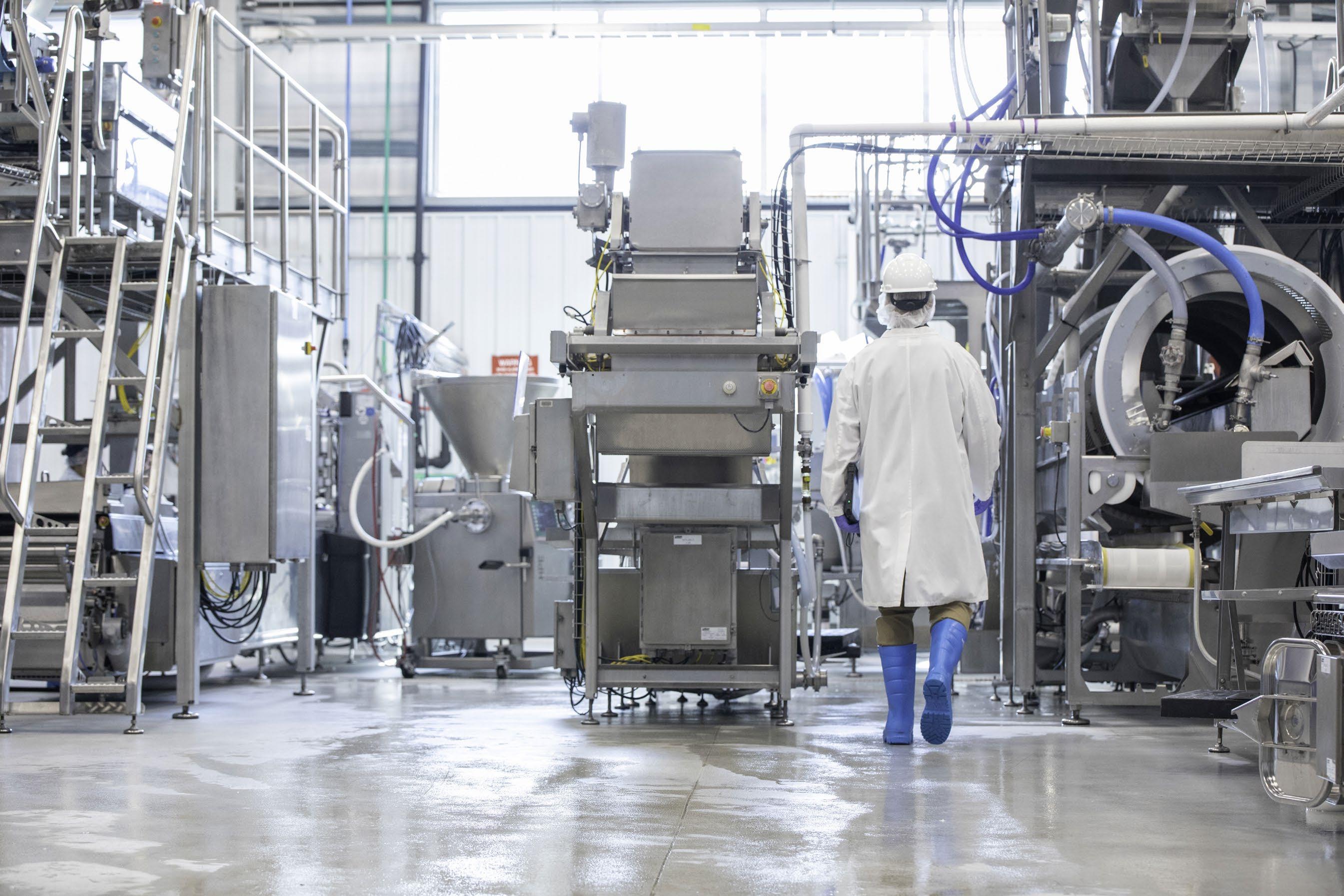
Created to optimize your direct food–contact conveyors, The Intralox® FoodSafe™ System is an unrivaled, in-depth approach to meeting your plant’s daily production goals sustainably.
Engaging in energy consumption monitoring offers invaluable insights into energy usage patterns, trends, and opportunities for improvement.
 By Andrey Bulatov, Sales Support Engineer, AMF Bakery Systems
By Andrey Bulatov, Sales Support Engineer, AMF Bakery Systems
+When systematically organized and seamlessly integrated into the daily activities of a bakery's operational team, energy monitoring becomes a potent tool. It sheds light on areas where energy is not being used efficiently, identifies points of waste, and quantifies potential savings. Moreover, it provides a foundation for developing and enacting targeted strategies to reduce overall energy consumption, fostering more sustainable and cost-effective operations.
Take, for example, the consumption optimization of bakery ovens, which is increasingly important as energy costs soar. Analyzing consumption rates is the only way to validate changes to the oven's operation, such as adjusting the pan gap or fine-tuning the burners. Without monitoring and analyzing energy use, any positive changes could go unnoticed, and the optimal settings might never be identified or implemented.
Another critical area is the industrial tray washing machine, which is notorious for being the largest consumer of water in the bakery, gulping down 50 liters per minute. Monitoring water usage is crucial. Given its fully enclosed design, detecting leaks in the water distribution piping becomes virtually impossible without insights gained from constant consumption monitoring. For example, a malfunctioning valve in a tray washing machine might go unnoticed, resulting in high monthly bills. This highlights how regular monitoring is essential to maintaining efficiency and preventing resource
wastage, as it provides necessary data to control consumption and promptly detect equipment malfunctions.
“Systematic energy consumption monitoring is not just a tool for identifying savings – it's a necessary component of effective operational management in a bakery, ensuring resources are used wisely and sustainability goals are met.”
Andrey Bulatov, Sales Support Engineer, AMF Bakery SystemsThrough examples such as these, it becomes clear that systematic energy consumption monitoring is not just a tool for identifying savings; it's a necessary component of effective operational management in a bakery, ensuring resources are used wisely and sustainability goals are met.
Effective energy monitoring hinges on setting clear goals and metrics. For instance, optimizing gas consumption for a bun or bread production line begins with analyzing the consumption of the oven. For any gas-fired oven, whether it is a continuous or tunnel type, the key metric to monitor is the gas consumption per unit of product, such as cubic meters per tonne. It is important to recognize that this ratio will vary for different products because of differences in oven occupancy. Therefore, calculating the oven occupancy rate
is crucial for figuring out how to use it more efficiently. Understanding this rate helps in optimizing oven usage by adjusting for product-specific occupancy, leading to more effective and efficient operations.
To accurately analyze oven consumption, it's vital to measure the quantity of product entering the oven, essentially tracking oven occupancy, and comparing this with the consumption recorded on the natural gas meter. Given the cyclical nature of bakery production, collecting hourly data is advisable. This granularity reveals the specific timing for each product, including during changeovers. This data is then mapped against the production schedule, enabling the calculation of consumption rates (always, in cubic meters per hour per tonne) for each product type – i.e., for bread, 4" buns, 5" buns, or hot dog rolls.
Subsequently, you can compare the consumption for identical products before and after, making positive equipment adjustments. Alternatively, if there's an increase in consumption, it prompts an investigation into what technological changes might have contributed to this uptick, ensuring that any adjustments in production methods are fully accounted for and understood regarding their impact on gas usage.
A practical approach is to compare similar production scenarios. For example, energy usage can be monitored throughout production cycles of the same type of baked goods. Monitoring software can track weekly changes and demonstrate the impact of optimizations, such as adjustments made to the burner air/gas proportions, fan speeds, on energy consumption.
Monitoring can highlight abnormal consumption patterns, which can lead to conducting unscheduled compressed air leak audits or examining control systems settings, when deemed necessary. The primary cause of abnormal consumption in air compressors is often air leakage. Unfortunately, detecting these leaks immediately is a challenge because of the high noise levels usually associated with production areas. The detection of air leaks is typically feasible during downtime or by employing specialized tools such as an Industrial Acoustic Imager. However effective this machine may be, it is nevertheless expensive.
Additionally, issues with the compressor control system may arise, which might inadvertently activate three compressors instead of the necessary two, to also include the spare one. In this scenario, consumption levels will be significantly elevated. Implementing a simple alarm system that alerts to such excesses can save thousands of euros daily by providing a prompt warning of overuse. There are substantial benefits to be gained when bakeries regularly track energy spending and analyze its efficiency.

Pinpointing the underlying cause of fluctuations in energy consumption is halfway through controlling them for correct resource allocation and process optimization. Having a well-maintained database with several years of data makes identifying fluctuations straightforward – both expected and out-of-the-ordinary events. It is normal to see a higher electricity consumption rate during summer months, driven by the increased operation of cooling equipment, for instance, such as the freezers' compressors and air conditioning units. Similarly, natural gas consumption typically rises in winter due to heating demands. These seasonal variations are normal and considered acceptable.
However, if there are changes in production technology or the addition of new units such as extraction systems, new packaging machines, or cleaning units, it is essential to correlate these with the consumption rate to avoid misunderstandings in the data analysis. Any other unexpected deviations in consumption should be thoroughly investigated to determine their cause, ensuring all adjustments are accurately reflected and understood in the context of overall utility usage.
Focusing on minimizing utility consumption – whether it's gas, or water, measured in cubic meters per ton of product, or electricity in kWh per ton of production – is pivotal to efficient baking, all the while ensuring no compromise on product quality.
Taking a continuous oven for bun production as an example, an inspection found that 3 of the 15 active burners showed an abnormal, mostly orange flame, indicating inefficient gas-air mixing and flame spread. By fine-tuning the gas-to-air ratio and decreasing the gas quantity in this mix, the flame turned blue again and achieved better propagation. This adjustment alone resulted in quantifiable savings of about 10% in total gas consumption.

This approach was also applied to other improvement areas, such as optimizing recirculation and exhaust fan speeds. Adding an extra heat-retention tunnel inside the oven also supports savings, further validating the effectiveness of these measures in enhancing efficiency and reducing utility usage.
Key steps for effective monitoring:
+ Installing separate meters: Place meters on major energy consumers and connect them to monitoring software.
+ Identifying and tracking key consumers: Monitor daily consumption KPIs of the main energy users.
+ Consistent comparisons: Compare the same product types and production cycles for accurate analysis.
+ Evaluating and maintaining improvements: Assess the impact of corrective actions and make successful changes permanent.
+ Enhancing monitoring procedures: Implement automatic alarm systems and integrate AI for advanced monitoring.
An automatic alarm system for abnormal consumption can quickly identify issues, preventing extra expenses. Future integration of AI in consumption analysis models could predict seasonal consumption peaks and optimize usage during critical periods.
Andrey Bulatov has a 16-year background in engineering, including food production. His expertise revolves around delivering complex project management solutions and optimizing high-speed automated line equipment maintenance. His first role in the baking industry was as Chief Engineer for a Grupo Bimbo bakery in Ukraine, in 2019. In this assignment, he led the maintenance department, focusing on the uninterrupted operation of bakery equipment and prioritizing energysaving initiatives. Early in 2022, he moved on to Bimbo QSR in Italy, where he took on project management responsibilities. This role further deepened his understanding of bakery
Adjustments to the oven’s setpoints need to be verified through product testing sessions and trials. Alterations in burner operation or air circulation, for example, can impact product quality; this can be detected and managed with the aid of a specialized thermal logger. Following the test, the baking curves of the product should be analyzed, to make any necessary final adjustments. Concurrently, the quality department should assess the product and provide feedback on its quality. If the quality meets standards and poses no risk to consumers, the new oven setpoint, which reduces gas consumption for a specific product type, can be approved.
In terms of electricity, air compressors are critical to focus on due to the extensive use of pneumatic equipment in bakeries. It is worth noting that, in the majority of bakeries, nearly 90% of the machinery, aside from basic conveying systems, utilizes pneumatics for various operations such as product movement, chain tension control, and vacuuming, through components including valves and pneumatic cylinders. These operations are supported by multiple air compressors known for their high energy consumption, as they are running non-stop. Having a backup compressor ready is essential to guaranteeing a constant supply and maintaining pressure levels above 6 Bar. Dropping below this pressure can cause interruptions in production and instability in equipment performance.
Consistent monitoring and data analysis results in significant cost savings by reducing energy consumption. That’s not all: the practice optimizes energy systems for better performance and longevity, while ensuring compliance with energy regulations.
Environmentally, it contributes to reduced greenhouse gas emissions, supporting global climate change mitigation efforts. A commitment to energy efficiency is an additional benefit as it enhances a bakery’s image among customers and stakeholders, providing a competitive advantage and opening new market opportunities. +++
operations and equipment functionality. The specialist consistently monitors the latest innovations in the bakery business and strives to incorporate them into practices. Throughout his tenure at Bimbo, Andrey Bulatov was at the forefront of implementing numerous energy-saving projects. In 2024, he joined AMF Bakery Systems, where his focus shifted from bakery operational engineering to application engineering and sales support. With an extensive background in quality control and workplace safety and expertise in supervising and training technical staff, Andrey Bulatov is passionate about supporting new start-ups and driving process enhancements within the baking industry.

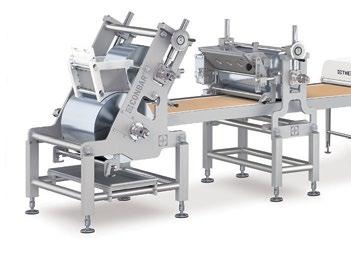
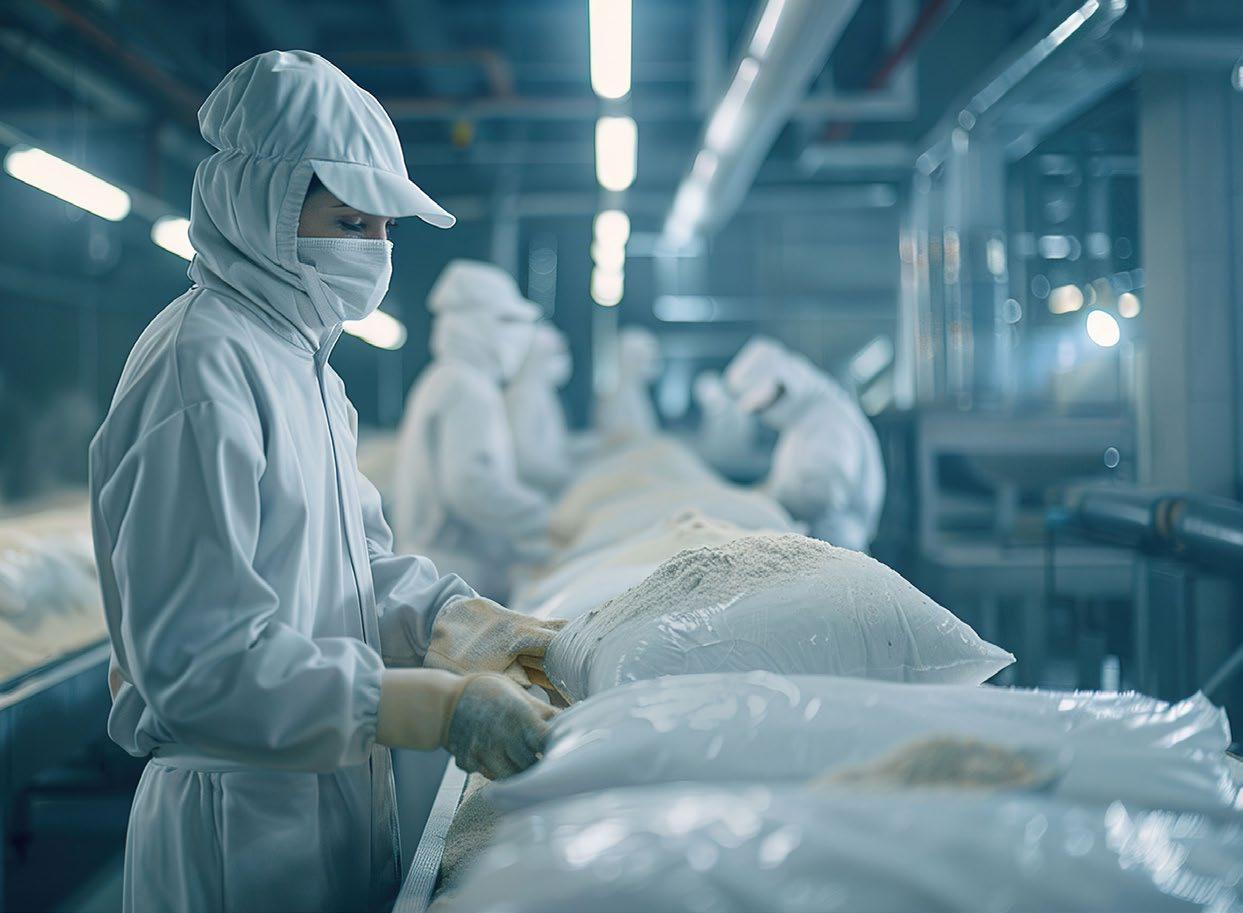
How to handle enzymes safely so that production teams remain free of respiratory issues and the products fully benefit from their functionality? This research is at the top of the list this year for Fedima’s Enzyme Expert Group. The European association representing the bakery, patisserie and confectionery ingredient manufacturers researches best practices and shares guidelines.
By Fedima+Flour and enzymes play essential roles in the baking industry. Flour dust, containing approximately 40 different protein allergens, can cause respiratory allergies and ‘baker’s asthma’. Enzymes, like other proteins, may act as respiratory sensitizers when people are repeatedly exposed to airborne dust containing them. Proper monitoring, process controls, product formulation, and appropriate handling instructions can significantly reduce the risk of worker exposure.
Introduction
Enzymes form a special class of proteins, produced by in all living organisms. Proteins are naturally produced by all living cells; all living organisms need enzymes to conduct virtually all the physiological processes essential for life. They act as biocatalyst in physiological processes essential for life, speeding up chemical reactions. For instance, amylases in saliva begins the process of breaking down starch in smaller pieces so our bodies can absorb them. Bakers have learnt to use enzymes in bread making and benefit from them for centuries.
Industrial enzymes have low toxicity in humans; i.e. enzymes present no concerns in terms of acute toxicity, genotoxicity,
sub-acute and repeated dose toxicity, reproductive toxicity and carcinogenicity. (1)(2)(3) However, like many other proteins, enzymes may act as allergens via inhalation.
Allergy symptoms may be similar to those of the common cold, and if such symptoms occur frequently at the workplace and only rarely at weekends or during holidays, they may be the result of occupational enzyme exposure. Allergy by inhalation caused by flour or enzymes is similar to the respiratory allergies caused by well-known allergens like grass-pollen, with similar symptoms as well. There is no scientific evidence that enzymes are associated with allergies caused by skin contact or ingestion. (4) (5) In general, minimizing flour and enzyme dust exposure in bakeries, flour mills, and bakery ingredient manufacturers will reduce the likelihood of work-related respiratory symptoms.
Inhalation allergies develop in two steps: sensitization and elicitation, with symptoms appearing upon repeated exposure to high airborne concentrations of the allergen. Symptoms of allergy to enzyme/flour dust, similar to those of common cold, include itching nose and eyes, nasal and sinus congestion, sneezing, coughing, hoarseness, chest tightness, and shortness of breath.
AMFEP and Fedima have developed guidelines for safe handling of raw materials and ingredients containing enzymes to safeguard the health of workers in the bakery supply chain.
The paper, “Industry Guidelines On the Safe Handling of Enzymes in the Bakery Supply Chain”, was developed by the joint Enzymes Safety Working Group, made up of members of the Association of Manufacturers and Formulators of Enzyme Products (AMFEP) and the Federation of European Union Manufacturers and Suppliers of Ingredients to the Bakery Confectionery and Patisserie Industries (Fedima).
Several measures should be simultaneously taken to prevent exposure to enzymes, starting with preventing dust formation by plant design, and including prevention of aerosol formation. In addition, dust/aerosol formation should be contained at the source, by using completely closed systems. Spillage throughout the process should be avoided. The design of the equipment used in the production chain should also support safe handling. Moreover, comprehensive training is a must, so that production staff is provided with clearly described guidelines and standard operating procedures.
The following control measures can be considered to prevent exposure:
+ Eliminating or substituting risk-prone materials and ingredients is the most effective step to prevent flour and enzyme dust formation. Since flour and enzymes are vital ingredients in any baking process, this measure does not directly apply. Historically, the baking industry first used enzymes produced in powdered form, and then gradually evolved towards using granulated or liquid formulations to reduce the risk of dust creation and inhalation
+ Isolation, enclosure and ventilation: these measures are applied when using closed systems for the transport and storage, and the blending and mixing of wheat flour and additional ingredients, including enzymes. NB: these measures may only be applicable in larger manufacturing units and large-volume production operations.
+ Mechanical control measures, including local exhaust ventilation, vacuum cleaning and protective equipment.
+ Respiratory Protective Equipment (RPE) or Personal Protective Equipment (PPE), including protective clothing, should be considered as a last resort of control; e.g., in specific situations with high risk of exposure or in case of emergencies. Face masks (FFP3) are in common use to protect against dust inhalation.
All exposure control measures should be based on risk assessment of the work place and deal also with GMP.
As it is automated to various degrees, industrial bakery manufacturing frequently includes the use of silos and closed dosing systems, which greatly reduces the exposure risk of the rest of the staff to possible dust formation. Very often, only one or two people are responsible for each process step.
Dust formation can still occur when filling and refilling small silos with dust-forming raw materials from big bags. In this case, specialized equipment should be used, to move materials from the big bag through an almost closed system into the silos. Nevertheless, since this is not a completely closed system, dust can form. It should be noted that, when using a system in which the inner big bag liner seals to the discharge equipment before the bag is opened, there is no spillage. Since the inner liner is sealed before automatically discharging the materials, handling materials that can create dust becomes entirely safe. However, the use of closed, automated dosing systems tends to be limited to large throughput and high-volume processes due to their cost.
Some bread specialties are still made with bagged powdered ingredients and additives. Occasionally, additives, ingredients and processing aids are used in liquid form, which makes automated dosing much easier and considerably reduces dust levels. However, the formation of aerosols is a serious risk to consider in such cases. Water and yeast are added through dosing pipes to the mixing bowl. Once the dough has been mixed, there is no further risk of enzyme dust formation.
When flouring conveyor belts to prevent dough from sticking, the flour is dispersed from low heights with minimal force, so dust formation at this step is negligible. The potential for enzyme dust formation is also very low.
1. Storage: silos are preferred and, when this is not applicable, there should be dedicated storage areas for bags of enzymes. Open bags should be sealed and portable vacuum cleaners should be used to clean up spillages.
2. Dry bulk ingredient weighing: closed systems should be used as well we local ventilation systems, placed above or behind the mixing bowl.
3. Weighing: some formation of dust will always occur at this stage, which is why a ventilation system at the weighing station is recommended. In the absence of automated ingredient delivery, local ventilation significantly reduces exposure to flour and improver dust. Respiratory protection equipment (RPE) should also be used.
4. Loading/unloading dry ingredients into the mixing bowl: when dry materials are manually delivered into
ALWAYS FOLLOW THESE IMPORTANT GUIDELINES
CONTAINMENT AND CONTROL OF ENZYME DUST AND AEROSOL SPRAY

Enzyme-containing ingredients must always be handled and processed in ways that avoid the formation of dust clouds or aerosol spray.
Engineering control measures should be in place to avoid the formation of dust or aerosol as far as possible.
Where any openings are unavoidable in the process then suitable ventilation and air flow control should be in place.
SAFE WORKING PRACTICES
Weighing of flour and ingredients:


Unloading flour and improvers from a silo into mixing bowls (semi-industrial craft bakery):

Unloading flour and improvers from bags into mixing bowls (artisan bakery):



SPILLAGE CLEAN-UP / CLEANING PLANT AND EQUIPMENT FOR INGREDIENTS THAT CONTAIN ENZYMES Always clean up immediately after any spillage.







the mixer, they should be slowly released from the bag. Making a slit into the bag at the opposite side from the opening will help dry materials slide out easier while avoiding shaking to bag. A local exhaust system should be put in place, above or behind the mixer. When dry materials are delivered from a silo, it should closely fit the mixer to avoid dust formation.
5. Dough preparation: as the biggest concentration of dust is bound to be created at the start of the mixing process, mixing bowls with a lid should be used. If the mixer features a grid-type cover, an extraction system should be installed. Adjusting mixing speeds also minimizes dust formation, by starting the mixing process at a slow speed and increasing it when all the dry and wet ingredients are blended. It is also recommended to limit the use of dusting flour in the mixing bowl and use a small amount of oil instead, at the end of the mixing process, whenever the product allows it.
6. Dough handling: automatic flour dusters usually disperse flour onto the conveyor belt to prevent the dough from sticking. If set correctly, they will only drop flour where it is needed and will do so in a way that does not lead to creating dust clouds. Workbenches made of materials such as inox, stainless steel and polyethylene should also be used, as the need for dusting flour spread is greatly reduced.
Dust exposure can damage our health!
Enzyme dust may provoke sensitization in the same way as inhaling common allergens like pollen or house dust.
Symptoms include red eyes, runny nose, shortness of breath and wheezing.
Flour and other bakery ingredients - like enzymes - are allergens
Exposure can be prevented or minimised to a safe level by:
Preventing the dust from becoming airborne.
Using appropriate protective equipment.
Always following the correct operating procedures.
BEST PRACTICES
Prevent dust formation.
Avoid spreading dust from one area to another.
Always clean up after a significant spillage.
Change your working clothes according to company instructions.

Some operations, for instance during spill clean-up, may require respiratory protection (a P3, FFP3 or N100 should be used).
Use additional protective clothing such as gloves and safety glasses to minimise any risk of skin contact.
FIRST AID MEASURES IN CASE OF EXPOSURE TO ENZYME
General advice: Seek medical advice from local first

7. Waste: packaging should be collected as soon as it is empty, in plastic bags if they were used to store powders.
8. Ventilation: filtration systems used in industrial bakeries can be quite sophisticated. At a minimum, the standard of filtration required is F8. After filtration, the extracted air should be discharged outside of the building, to prevent dust formation inside the facility.
Reducing dust exposure: practical steps
+ Purchasing: wherever possible, non-dusty raw materials should be sourced. For example, liquids, pastes, or grades of powdered ingredients that have large particle sizes should be selected, or materials that have been treated to minimize their capacity for dust creation.
+ Goods inwards: enclosed pipes are recommended, whenever possible, for the intake of dusty raw materials. Otherwise, puncturing or rupturing the packaging of powdered materials should be avoided. To further protect it, storage pallets should be undamaged and free from splinters.
+ Debagging/unboxing: staff should be trained and encouraged to unpack powdered materials in a way that doesn’t create dust clouds (e.g., bags of powdered ingredients/flour should not be shaken from heights). A standard operating procedure is recommended when
handling partly used bags, to carefully close, reseal and store partly used bags of enzyme-containing ingredients to minimize dust formation. All such bags should be stored in an area with easy access for the safe cleaning of any accidental spillage.
+ Using face masks, safety goggles, gloves, respirators, etc.: staff members should be aware that the use of personal protective equipment (PPE) still means they should handle powdered materials carefully. PPE is intended to minimize risks, not ensure protection from clouds of dust that are created by careless handling.
+ Extraction and ventilation: make appropriate use of extractors and ventilators in areas that may be particularly susceptible to a dusty atmosphere; e.g. in weighing, mixing and blending areas.
+ Spillages: vacuum cleaners fitted with appropriate HEPA filters should be used when handling dusty material spillages, while also ensuring that the vacuumed contents do not create dust clouds when emptied. Where dust is required during a process (e.g. when producing bread or pastry on an automatic line), equipment that drops flour only where it is needed should be used. If excess flour dust needs to be removed at any stage, an extraction unit should be installed over the line, or
suitable guards to prevent dust from being discharged into the atmosphere. If possible, ‘non-dusty’ flours should be used for this purpose. Spillages should be addressed as soon as they occur.
Monitoring should be prioritized based on the risk of exposure to workers. The basis for the sampling strategy in workplace air is the EN689 standard. Routine air sampling is a quantitative tool to measure levels of background exposure to enzymes and dust, whereas peak sampling is used to measure high-risk exposures. Air monitoring can be undertaken with either high- or low-volume samplers.
Area sampling is used to evaluate the effectiveness of control measures and trends in performance, and is typically done at a fixed location; it can readily provide an indication of employee exposure. The personal exposure level is typically a factor 2 to 5 higher, depending on the direct tasks.
Personal sampling involves a sampling train (pump-tubingsampler-collection substrate). Low-volume devices are primarily used, but there are also wearable high-flow pumps on the market. However, the use of personal sampling is limited.


In-depth knowledge of dough technology is a key ingredient required for the production of high-quality bakery products. With over 40 years of experience in the bakery industry, Rademaker is expert in this field. This know-how, combined with specific sheeting process expertise, overall production process insights and cost of ownership calculations, are used to develop the very best bakery equipment solutions that will work for you.

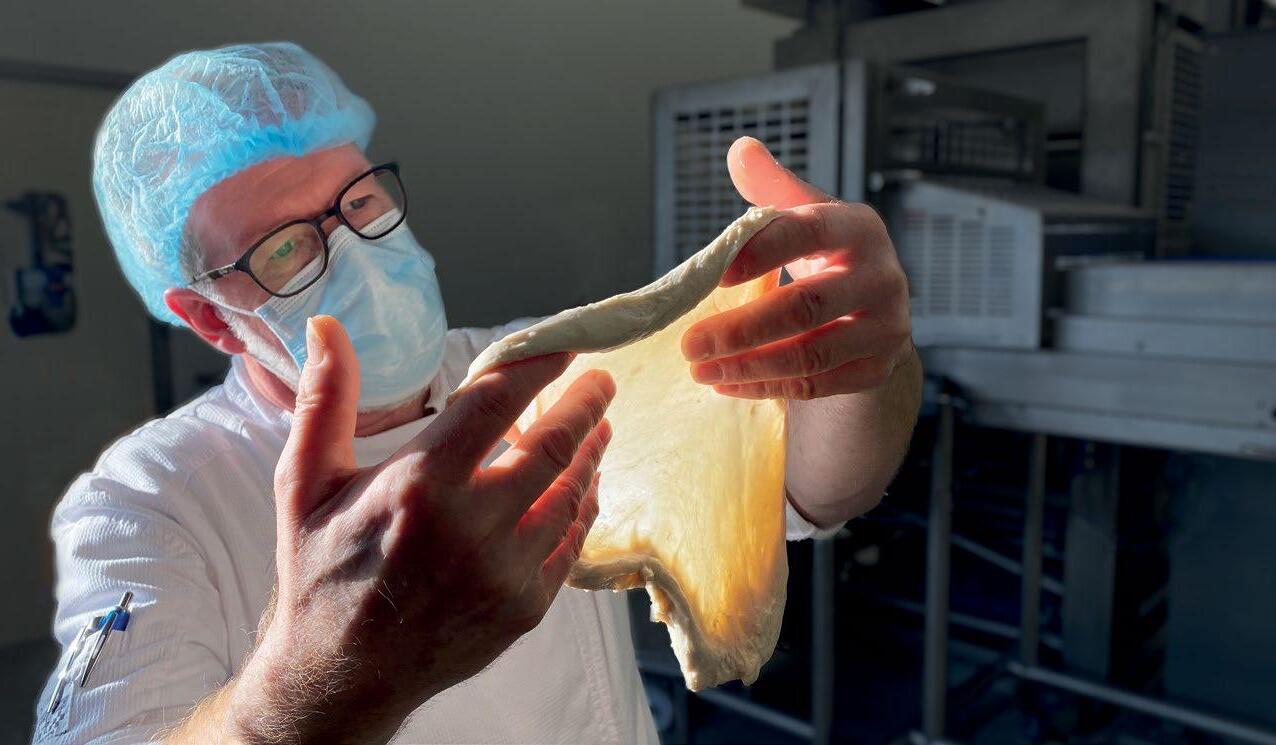
It is good practice to measure both total inhalable dust and enzyme airborne dust in the bakery supply chain. Only enzyme aerosol levels are measured in liquid operations. As the limit values are mainly for the inhalable fraction, an inhalable aerosol sampler should be used. Enzyme suppliers can be contacted for advice on measuring inhalable enzyme dust.
There are two toxicological end-points as a consequence of enzyme dust exposure: respiratory allergy, which is an intrinsic hazard for all enzymes, and skin irritation, which is an intrinsic property of enzymes belonging to the class of proteases. In addition to alpha-amylases and glucoamylases, other enzymes may be used in bakery, such as cellulases, lipases, xylanases and proteases. The main safety concern associated with enzymes is their potential to induce respiratory allergy, as these effects are practically irreversible.
Unfortunately, the relationship between airborne exposure to enzymes and the development of sensitization or allergy is still poorly understood. Although enzyme formulations have recently been improved, changing from very dusty powder to less dusty granular, paste-like and even liquid enzyme formulations, there are still situations where the number of enzyme allergies is on the rise due to the lack of awareness among workers and poor management.
Workers potentially exposed to enzymes should undergo medical examinations periodically, according to what is established by the risk assessment of the specific workplace and following legal obligations. Health surveillance is highly recommended for all employees in the bakery supply chain who may be exposed to flour and bakery ingredients, especially enzymes.
During the first 24 months of employment, workers should have six-monthly health surveillance checks and thereafter a minimum of every 12 months. The review should include a periodic respiratory questionnaire, spirometry and an immunological test. Those with normal findings may continue to work until the next examination. Those who have developed a positive immunological test result to enzymes and have no other adverse findings may continue to work with enzymes, although an increased frequency of medical surveillance of such workers may be appropriate.
Those with abnormal findings to the respiratory questionnaire which could be due to enzymes and those with impaired lung function should immediately undergo further assessment. They should also be re-tested within one month or at the discretion of occupational health professionals. Those who show a continuing downward trend in lung

function should be carefully assessed regarding the need to remove them from further work with enzymes. It is important to emphasize that the risk of respiratory sensitization to enzymes is solely occupational. Enzymes used in the bakery industry will be denatured during the baking process and eubsequently lose their potential sensitizing capability. Additionally, enzymes are in general not associated with food allergies (allergy as a result of oral exposure).
The ‘Industry Guidelines on the Safe Handling of Enzymes in the Bakery Supply Chain’ paper is available for in-detail consultation on Fedima’s website (https://bit.ly/enzymesafety). +++

References:
1. Basketter, D.A., Berg, N., Kruszewski, F., Sarlo, K.S., 2012. The toxicology and immunology of detergent enzymes. J. Immunotox., 2012; 9(3): 320-326
2. Basketter, D.A., Berg, N., Broekhuizen, C., Fieldsend, M., Kirkwood, S., Kluin, C., Mathieu, S., Rodriguez, C., 2012. Enzymes in cleaning products: An overview of toxicological properties and risk assessment/management. Regulatory Toxicology and Pharmacology 64 (2012) 117-123
3. Basketter, D.A., Broekhuizen, C., Fieldsend, M., Kirkwood, S., Mascarenhas, R., Maurer, K., Pedersen, C., Rodriguez, C., Schiff, H.E., 2010. Defining occupational and consumer exposure limits for enzyme protein respiratory allergens under REACH. Toxicology 268, 165-170
4. Basketter, D. A., English, J. S. C., Wakelin, S. H., & White, I. R. (2008). Enzymes, detergents and skin: facts and fantasies. British journal of dermatology, 158(6), 1177- 1181.
5. Bindslev-Jensen, C., Skov, P. S., Roggen, E. L., Hvass, P., & Brinch, D. S. (2006). Investigation on possible allergenicity of 19 different commercial enzymes used in the food industry. Food and chemical toxicology, 44(11), 1909-1915.


Oat powders
• organic
• non-organic Our product range

Easy handling for further processing in your products, with our quickly soluble oat powders:
• For the confectionery industry (chocolate, baked goods and much more)
• In the dairy industry (desserts, drinks, ice creams and much more)
Our instant organic oat powder and oatgurt powder stands out for:
Please contact us for more information: sales@schwarzwaldmilch.de


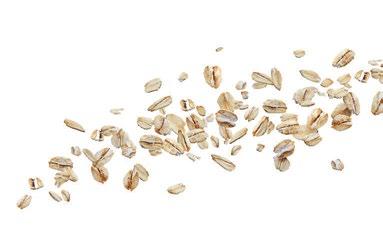
www.schwarzwaldmilchdairyingredients.de/en/vegan-ingredients/



The aim of this study was to better understand the (non-equilibrium) physics of fondants (Hartel & Nowakowski, 2017) at the microscopic level in order to be able to control processes more precisely. For this purpose, simple model systems consisting of water and sucrose were investigated.
By Hannah M. Hartge, Eckhard Flöter and Thomas A. Vilgis+Fondants, special sugar glazes or pastes, have a silky mouthfeel that is created by tiny crystals dispersed in a saturated syrup (Lees, 1965, Porter & Hartel, 2013). The relation between the high viscosity and small crystal size is the decisive physical parameter. This exceptional state can only be achieved with supersaturated sugar solutions, coupled with a complex kneading process and temperature control. This results in a metastable state that balances the syrup concentration and crystal size distribution. In practice, a fondant is produced by reducing a hot sugar syrup to high concentrations of 80 - 92% sucrose by weight, cooling it, and stirring or kneading the supersaturated system. Stirring causes rapid nucleation and crystal growth, while at the same time – under the right conditions – limiting the size of the resulting crystals to between 1 and 20 µm in diameter, so that they are not perceived as disturbing during oral processing.
Despite the simple composition, the physics of the supersaturated, thermodynamically metastable solutions of the fondants is largely unknown. Furthermore, crystallization takes place under shear with high forces and controlled cooling. Growing crystals are pushed against each other under high forces, causing them to break apart again or grow even together in defect-rich structures with many grain boundaries. At the same time, the collisions under high shear forces limit the growth of the crystals (Garabedian & Strickland-Constable, 1972). At first glance, the production of fondants therefore appears to be under conditions far from thermodynamic equilibrium. It is, therefore, necessary to separate
temperature and shear-related processes under physically controlled conditions to better understand the technologically relevant flow and crystallization behavior of fondants (Smolikhina & Muratova, 2014).
For the sugar solutions, crystalline white sucrose (extra fine) was dissolved in MilliQ water. To prepare the supersaturated solutions, 20% water was initially combined with 80% sucrose by weight for all samples. This ensured a complete dissolution. The mixture was then boiled down and repeatedly weighed until the desired sucrose concentration of 80%, 82.5%, 85%, 87.5% or 90% (w/w) was achieved. The final temperatures of the samples were between 110°C (80% sucrose) and 120°C (90% sucrose). After rapid cooling, they were placed in a water bath at a temperature corresponding to the desired kneading temperature. When the solution had reached a temperature of about 5°C above the kneading temperature, the syrup was added to the measuring kneader, which in turn was pre-tempered with a water circulation system. Stirring was carried out in an IKAVISC MKD 0.6 – H60 measuring kneader (IKA Werke GmbH & Co. KG, Staufen, Germany) for highly viscous samples (see figure). The mixer was operated at its maximum speed of 67 rpm and data on speed, temperature and torque were recorded.
In order to follow the crystallization, samples were taken at different kneading times and examined under a light microscope. The stirring of the sample was stopped after 200 s, 400 s, at the torque minimum, at the peak time of
Time/s

Time/s
the torque and after the complete process. The crystallized samples were immediately diluted with pre-tempered, saturated sucrose solution (25°C). This sucrose solution was previously stirred with 70g sucrose and 30g distilled water in a glass beaker covered with Parafilm at 400 rpm overnight and then centrifuged at 15,000 g for 10 minutes at 25°C. The sucrose that settled to the bottom was left in the centrifuge tubes to ensure continuous saturation. The saturated solution was taken from the top of the supernatant only. The fondant sample was then mixed by hand with the saturated solution using a flexible, disposable spatula. The mixture was pipetted onto a glass slide, then carefully covered and spread with a coverslip. Eight images of each sample were taken with a digital camera mounted on a Zeiss AxioScope.A1 (Carl Zeiss AG, Oberkochen, Germany) in brightfield transmission mode at 20x magnification. At least four microscopy images per time and sample were considered for particle characterization. The measuring kneader and typical results are shown in the figure.
Supersaturated solutions at rest belong to labile or physically metastable systems. Classical nucleation theory predicts that temperature and supersaturation drive the nucleation rates in such solutions exponentially (Kalikmanov, 2012). However, at very high concentrations, the low mobility and diffusivity of the sucrose molecules hinder crystallization. This is particularly true near the glass transition, when the molecular mobility is already very low, so that crystallization occurs only slowly. If such a system is heavily sheared, the probability of subcritical nucleation nuclei coming closer together increases. This in turn leads to increased nucleation and desired rapid crystal growth.
For this purpose, sugar solutions with concentrations of 80% to 90% sucrose content by weight were stirred in a temperature-controlled laboratory mixer and observed during crystallization. With the selected concentration range, they represent model systems for both the poured fondants
frequently used in confectionery (80% to 85%) and for fondant confectionery (85% to 90 %). The absence of additives such as glucose syrup allows a clear interpretation of the basic physical processes.
A characteristic pattern of the torque curve can be recognized for all samples, which correlates directly with the viscosity: While a more or less pronounced plateau is formed at the beginning of the process, the torque then shows a clear drop followed by a strong peak, as shown in Fig. 1 (Hartge, Flöter & Vilgis, 2023). The processes during these typical torque curves can be summarized in simple terms as follows: At the beginning of the kneading time, there are no or only a few crystal nuclei in the solution. Consequently, the torque at the beginning of the kneading process is largely due to the high viscosity of the supersaturated solution. Gradually, emerging crystal nuclei begin to grow, which initially remain small but reduce the concentration of sugar dissolved in the water. The viscosity decreases as long as the nuclei remain small and do not hinder each other; consequently, depending on the supersaturation, the torque may decrease significantly.
However, energy is simultaneously released during crystallization, so the temperature in the measuring kneader rises slightly before the torque peak, and the viscosity drops additionally. A further increase in temperature is to be expected due to the increasing friction as soon as sufficiently large crystals have formed and begin to hinder each other under the shear forces. In fact, despite cooling, a slight temperature rise can be measured inside the kneading trough until the torque minimum is reached before the rise. This observed temperature rise is around 2°C. However, these temperature changes are by no means solely responsible for the dramatic drop in torque. The measured torque drops by around 75 % of the initial value for all 25°C samples. This can be seen in the graphs in Fig. 1a, for example, for the sample with 85% sucrose: Here the torque decreases from about 3.3 N m to about 0.86 N m. Literature data (Mathlouthi & Génotelle,
1995) show that for a solution with 85 % (w/w) sucrose, a viscosity of about 237 Pa s at 25°C and a decrease to about 172 Pa s with a temperature increase of 2°C can be expected. This results in a decrease in viscosity of about 27%, much less than the observed 74%. Even assuming an error in the temperature measurement and allowing for a temperature rise of 5°C, this should result in a decrease of about 54%, still much less than the observed value. This therefore supports the interpretation proposed here.
For example, if we consider the point at which the concentration of dissolved sucrose has fallen from 85% to around 83%, the suspension only contains just over 1.8% by volume of hard particles. At the same time, the empirical values show a drop in viscosity from 237 Pa s to only 59 Pa s in the continuous liquid phase due to the reduction in syrup concentration. The apparent overall viscosity in this first stage therefore depends mainly on the dilution of the syrup due to crystallization, in which the crystals are largely freely dispersed.
If the crystals continue to grow irregularly in the solution, they begin to interfere with each other more and more during kneading, collide and are pressed against each other in the limited volume in the kneader. As larger crystals break into smaller ones, the surface-to-volume ratio increases, favoring further crystal growth. This increases the packing density, leading to higher shear forces. Consequently, a higher torque is measured, which increases up to the peak maximum. In simple theoretical models, this results in a singularity of viscosity (Russel, Wagner & Mewis, 2013). However, singularities in the viscosity are physically impossible because the high forces during the collisions at the peak maximum deform the crystals and break them apart at the grain boundaries and defect lines. Sizes and size distributions change, and the crystals become smaller on average and more regular. As a result, the overall viscosity and thus also the torque decrease again, and stabilize with longer kneading times.
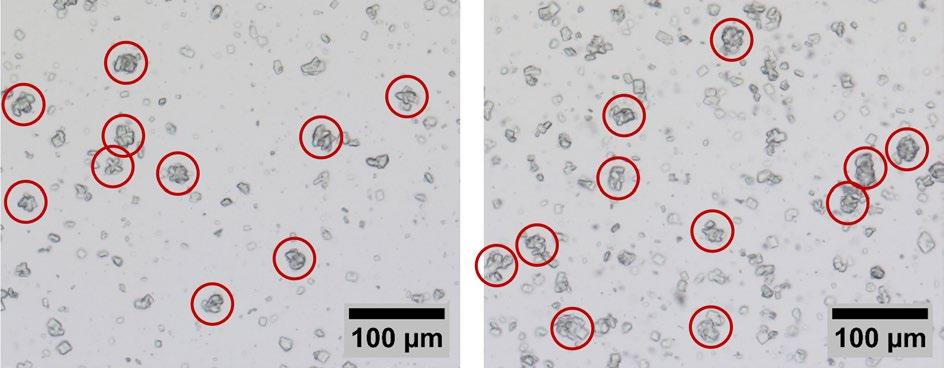






3: Sketches based on microscopy images of the crystallization process from a homogeneous solution (a) at the beginning of the process, (b) after 200 s, (c) at the minimum of the measured torque, (d) at the maximum and (e) after completion of the kneading process
The comparison of samples prepared at different temperatures (e.g. 25°C and 44°C) shows smaller peak maxima at higher temperatures. This can be explained by a higher sucrose solubility and thus a lower proportion of crystallized sucrose, but also by a lower viscosity of the liquid phase. The times until the peak occurs are also significantly shorter at higher temperatures, which can be explained by the higher mobility of the sucrose molecules.
Microscopic images of a sample with 85% (w/w) sucrose, which was kneaded at 25°C for 200 s, 400 s and up to the minimum, show the start of crystallization in the first 200 s. Furthermore, a clear crystallization of the samples can be seen at the times of the torque minima.
After further crystallization, at the peak of the torque, the increasing volume fraction of the crystals exceeds a critical value at which the crystals interfere with each other during shearing. The friction between the growing hard crystals then increases faster than the decreasing solution concentration lowers the viscosity. This in turn leads to a significant increase in torque. Fig. 2 shows typical snapshots of crystallization near the peak (a) and at the end of the kneading process (b).
A striking feature is the high number of irregularly shaped crystal conglomerates, as is commonly observed in highly supersaturated solutions due to the simultaneous strong nucleation in multiple locations. Crystals grow rapidly,
Literature
Mathlouthi, M. & Génotelle, J. (1995). Rheological properties of sucrose solutions and suspensions. In Sucrose: properties and applications (pp. 126-154). Boston, MA: Springer US.
Garabedian, H., & Strickland-Constable, R. F. (1972). Collision breeding of crystal nuclei: Sodium chlorate. I. Journal of Crystal Growth, 13, 506-509.
Hartel, R. W., & Nowakowski, C. M. (2017). Non-equilibrium states in confectionery. In Non-equilibrium states and glass transitions in foods (pp. 283-301). Woodhead Publishing.
Hartge, H. M., Flöter, E., & Vilgis, T. A. (2023). Crystallisation in highly supersaturated, agitated sucrose solutions. Physics of Fluids, 35(6).
Kalikmanov, V. I. (2012). Classical nucleation theory. In Nucleation theory (pp. 17-41). Dordrecht: Springer Netherlands.
collide and form new grain boundaries. This irregular structural formation is promoted by the constant shearing. Together with secondary nucleation – the formation of nuclei on existing solid material –, this can lead to numerous conglomerates rich in crystal defects, which are connected to each other by sub-optimal lattice sites. Towards the end of the kneading process, the number of larger conglomerates is significantly reduced, while at the same time, the smaller crystals continue to grow or disappear.
The collisions during kneading, the resulting friction and the increasingly high shear forces break up conglomerates at defect lines and grain boundaries. The surface area increases in relation to the volume, which in turn favors the crystal growth of the smaller fragments. As a result, more regularly grown crystals are formed, as can be observed towards the end of the kneading process. This can be explained by the fact that in the later phases of the process, the supersaturation in the liquid surface becomes less and less, which reduces the pressure on crystal growth and thus produces more regular crystals with fewer defects. Fig. 3 schematically summarizes the entire process of crystal formation and crystal shapes of the respective stages.
In combination with light microscopic images taken at different times during the process, it is concluded that a) a decrease in the sucrose concentration in the liquid phase leads to a decrease in the measured torque, b) a large
Lees, R. (1965). Factors affecting crystallisation in boiled sweets, fondants and other confectionery. British Food Manufacturing Industries Research Assoc. Porter, T., & Hartel, R. W. (2013). Quantifying sucrose crystal content in fondant. Manuf. Confect, 93, 61-64.
Russel, W. B., Wagner, N. J., & Mewis, J. (2013). Divergence in the low shear viscosity for Brownian hard-sphere dispersions: At random close packing or the glass transition? Journal of Rheology, 57(6), 1555-1567.
Smolikhina, P., & Muratova, E. (2014). Technological aspects of the results on rheological studies of candy mass. In 9th Baltic Conference on Food Science and Technology "Food for Consumer Well-Being" (p. 105).


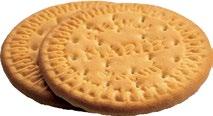
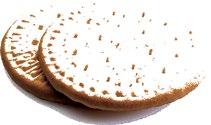





number of crystal conglomerates are formed initially and that c) these conglomerates largely break apart during further kneading, while smaller crystals continue to grow, leading to a peak value and a subsequent decrease in torque.
Despite the high viscosity, the system remains above the glass transition. Data from the literature yield diffusion constants of DTg ~ 10-24 m 2 /s at the glass transition temperature Tg, which would result in a glass transition temperature of Tg ~ -16°C for these systems. Therefore, as shown by Hartge, Flöter & Vilgis (2023), fondant production can be described with the approaches of classical nucleation and thus with equilibrium thermodynamics, although the processes appear to be far from equilibrium. The reason lies in the clear time scale separation, i.e. extremely slow diffusion times in the solution compared to the external time scales induced by kneading.
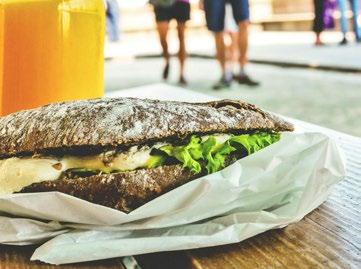
pexels.com
© Lum3n –
The Bread Initiative released a vision paper, titled ‘Keeping Bread on the Table’ ahead of the European Parliament elections, held from June 6 to 9 this year, highlighting key requests that should guide policymaking during the next EP term. The paper was signed by the five European trade associations behind the Bread Initiative: AIBI, CEBP, COFALEC, European Flour Millers and Fedima.
The document underlines that bread can play an important part in maintaining a healthy lifestyle and healthy eating habits. The Bread Initiative advocates for upholding ‘Better Regulation’ as a cornerstone of the EU regulatory process, rooted in its core principles and committed to minimizing bureaucratic complexities, which is seen as critical for all businesses, especially so for small bakeries.
Dr. Oetker’s food companies (including Conditorei Coppenrath & Wiese) increased their total sales by 6.9%, to EUR 4.2 billion in the 2023 financial year. In 2022, its sales amounted to EUR 4 billion. Dr. Oetker invested around EUR 171 million last year. Around 65% of its total sales are outside of Germany. Innovative, sustainable and healthier products were a key
These fundamental physical findings contribute to a better understanding of the physical processes involved in the crystallization of sucrose outside the thermodynamic equilibrium, as they occur in particular in the production of fondant for sugar glazes, as on donuts, or fondant confectionery. +++
Hannah M. Hartge 1,2 , Eckhard Flöter 2 and Thomas A. Vilgis 1
1 Max Planck Institute for Polymer Research, Ackermannweg 10, 55128 Mainz
2 Institute of Food Technology, Technische Universität Berlin, Straße des 17. Juni 135, 10623 Berlin
The key requests that should guide policy-making during the next European Parliament term (2024-2029) were identified in the vision paper as follows:
+ Food security: ensure the availability of local breadmaking wheat
+ Red tape: streamline EU legislation, while reducing disproportionate regulatory burdens
+ Sustainability: support the transition to more sustainability in the bread supply chain
+ Nutrition and health: recognize the crucial role of bread in European citizens’ diets
+ Energy: secure access to affordable energy within the bread supply chain
+ Workforce: help promote skills & education for young bakers and millers in Europe
The paper has received support from baking organizations worldwide. The Bread Initiative platform is open to other associations of the bread value chain. The aim of the breadinitiative.eu is to improve bread’s image and emphasize its health value and the European cultural heritage associated with this product. +++

© Dr. Oetker
success factor for Dr. Oetker in the 2023 financial year: Dr. Oetker expanded its range of frozen snacks to include the first vegan Bistro Baguette in the Spicy BBQ Vegan variety, for example. The company also expanded its portfolio of plant-based products. +++
Series: specialty topics
Title: Sustainability and innovations supporting it
Publication: 2023
200 pages, EUR 49*

*Price with VAT, for hard copy and e-copy. Transport costs not included.

As consumers redefine breakfast to suit their changing daily agendas, opportunities arise for brands to meet them, for this eating occasion in all its forms.
By Kate Kehoe, Marketing Executive at FMCG Gurus+Morning is the time of day in which many consumers tend to be more health-orientated. FMCG Gurus’ consumer insights suggest that at this time of day, factors including indulgence and escapism are less likely to impact consumption habits. For instance, 74% of global consumers describe their eating and drinking habits as healthy during the early morning. This could be because consumers deem breakfast as integral to following a healthy lifestyle. As a result, consumers tend to be more attentive to the nutritional value of breakfast foods and drinks.
However, it is important to note that three in ten global consumers state that they do not eat breakfast every day. This highlights that modern-day, busy lifestyles are impacting mealtime structures and leading to time scarcity among many consumers. As a result, it is likely that consumers are replacing breakfast time with a quick and convenient snack. To address this, brands should offer nutritional and convenient breakfast options to cater to consumers who are ‘on the go’.
Approximately one-third of global consumers admit to occasionally skipping breakfast each week, according to FMCG Gurus’ market research. This trend reflects a shift away from regimented meal times towards more casual eating occasions and snacking throughout the day. When consumers opt to skip a meal, it's common for them to substitute it with a snack. As a result, snacks are no longer viewed
solely as indulgent treats, but rather as sources of nutritional value that contribute to a healthy and balanced diet. This is especially significant in the morning, a time when consumers prioritize wellness.
Traditionally, consumers are more inclined to skip breakfast or lunch as opposed to dinner, often due to fewer personal and professional commitments in the evening. While skipping breakfast is more prevalent among younger adults, it is a trend observed across all demographics as individuals perceive themselves as increasingly time-pressed.
Even prior to the current surge in living costs, numerous consumers faced challenges with everyday expenses, especially regarding the cost of groceries. The escalation of prices is further worsening these difficulties, prompting many individuals to adapt their shopping and consumption behaviors to stretch their budgets. The cost-of-living crisis presents significant hurdles for consumers for two primary reasons. Firstly, only about one in four households worldwide report having sufficient financial savings, according to FMCG Gurus’ consumer insights. Secondly, consumers are increasingly feeling the impact of rising prices on essential grocery items.
Increasing prices directly influence breakfast food consumption. For instance, FMCG Gurus’ market research reveals that three in ten consumers have indicated that they have eaten
breakfast less frequently in the past year to save money. This demonstrates that the current cost crisis is affecting not only indulgent spending but also individuals' overall well-being. The breakfast industry needs to address this by emphasizing the health benefits of breakfast and exploring new strategies to enhance the perceived value of breakfast options.
Morning is the time when everyone is more likely to consider healthier eating choices; when asked about the food and drink products they rely on to improve their health, consumers consistently listed items commonly associated with the breakfast table as their top choice. For instance, FMCG Gurus’ consumer insights highlight
that 63% of global consumers turn to breakfast cereals to boost their health, followed by yogurt, dairy probiotics, and milk.
At a time when consumers are considering reducing their breakfast consumption, it is critical for the industry to address this by educating people about the connection between regular, structured breakfasts and long-term wellness. Over the past few years, many consumers have reported improvements in their health due to their proactive approach to wellness aimed at reducing their susceptibility to disease and illness. The breakfast industry must actively encourage consumers not to undo the progress made during this period, by promoting morning consumption as healthy,
convenient, and delicious, ultimately enhancing the perceived value of breakfast.
This article is based on FMCG GURUS: Reinvigorating the Breakfast Market – Global Report 2023. For more information, please contact us at info@fmcggurus.com.


to your inbox every other Wednesday. www.bakingbiscuit.com



Puratos opened a new Sourdough Institute, a hub dedicated to celebrating the art, science and potential of sourdough. The Institute in Sankt Vith, Belgium, aims to “protect, research and inspire” the legacy of the popular ingredient on a global scale through work including masterclasses, online events and research. The new institute is also home to the well-known Sourdough Library, where 153 sourdoughs are currently stored, to ensure strain biodiversity in the future. Karl de Smedt was appointed head of the Sourdough Institute.
The Institute will organize a variety of masterclasses, led by sourdough librarian Karl de Smedt and selected bakery experts. These hands-on classes will share best practice tips, techniques and recipes, as well as the science behind sourdough and its contribution to health and well-being, Puratos highlights.
Puratos’s Sourdough Institute will also focus on scientific research to uncover more about the benefits and potential applications of sourdough, and the art of making and using it. As part of this research, Puratos is working on a predictive model providing measurements including digestibility score, sustainable credentials, flavor, and shelf life, to help bakers improve the taste, health profile and sustainability of their creations. +++
Vandemoortele announced the acquisition of Dolciaria Acquaviva SpA from Apheon, a mid-market private equity firm, and the Acquaviva family. The Italian business is an established manufacturer of frozen pastry, patisserie, and savory specialties. Pierluigi Acquaviva will continue to be part of Acquaviva as Chairman of the Board of Directors.
The terms of the transaction, which is expected to be concluded soon, were not disclosed.
Headquartered in Gricignano d’Aversa (Caserta), Dolciaria Acquaviva had a turnover of around EUR 120 million in 2023 and has over 200 employees. It runs four industrial plants in Italy, which serve more than 40,000 HoReCa customers daily across Italy. +++
PUBLISHING HOUSE
baking+biscuit international is published six times a year.
Single copies may be purchased for EUR 15. Subscription rates are EUR 75 per annum. Students (with valid certification of student status): EUR 40. (All rates include postage and handling, but not VAT).
Cancellation of subscription must be presented three months prior to the end of the subscription period in writing to the publishing company. Address subscriptions to the above stated distribution department.
Claims will not be accepted for any copies not received or lost copies due to reasons being outside the responsibility of the publishing company. This magazine, including all articles and illustrations, is copyright protected. Any utilization beyond the tight limit set by the copyright act is subject to the publisher’s approval.
Online dispute resolution in accordance with Article 14 Para. 1 of the ODR-VO (European Online Dispute Resolution Regulation): The European Commission provides a platform for Online Dispute Resolution (OS), which you can find at http://ec.europa.eu/consumers/odr
Valid advertising price list: 2024
Food2Multimedia GmbH Schoolkoppel 27 21449 Radbruch, Germany +49 4178 244 9797 www.foodmultimedia.de
EDITOR EMERITUS
Hildegard M. Keil hildegard_keil@t-online.de
PUBLISHER
James Dirk Dixon dixon@foodmultimedia.de
EDITOR-IN-CHIEF
Catalina Mihu mihu@foodmultimedia.de
EDITOR
Helga Baumfalk baumfalk@foodmultimedia.de
COPY EDITOR
Annie Dixon annie.dixon@foodmultimedia.de
SUBSCRIPTIONS Viktoria Usanova usanova@foodmultimedia.de DISTRIBUTION vertrieb@foodmultimedia.de
ADVERTISING Dirk Dixon dixon@foodmultimedia.de
SOCIAL MEDIA
Annie Dixon annie.dixon@foodmultimedia.de
LAYOUT/GRAPHIC
LANDMAGD Design aus der Heide
Linda Langhagen, design@landmagd.de
Leinebergland Druck GmbH & Co. KG Industriestr. 2a, 31061 Alfeld (Leine), Germany
IT IT Consulting BRUNK Felix Brunk, felix@brunk-net.de




